Assessment of Wildfire Activity Development Trends for Eastern Australia Using Multi-Sensor Earth Observation Data
Abstract
:1. Introduction
2. Materials and Methods
2.1. Area of Interest
2.2. Utilized Data Sources
2.3. Burnt Area Derivation Methodology
2.4. Validation of Burnt Area Data
- True positives (TP): The total burnt area contained in the presented results as well as the reference data, in relation to the total burnt area of the reference data.
- False negatives (FN): The total burnt area not contained in the presented results, but contained in the reference, in relation to the total burnt area of the reference data.
- False positives (FP): The total burnt area contained in the presented results, but not contained in the reference area, in relation to the total burnt area of the reference data.
2.5. Trend Derivation Methodology
3. Results
3.1. Fire Trends Regarding the States in the Study Area
3.2. Fire Trends Regarding Climate Zones
3.3. Fire Trends Regarding Ecological Units
3.4. Combination of Results from Different Levels
4. Discussion
5. Conclusions
Author Contributions
Funding
Institutional Review Board Statement
Informed Consent Statement
Data Availability Statement
Conflicts of Interest
Appendix A
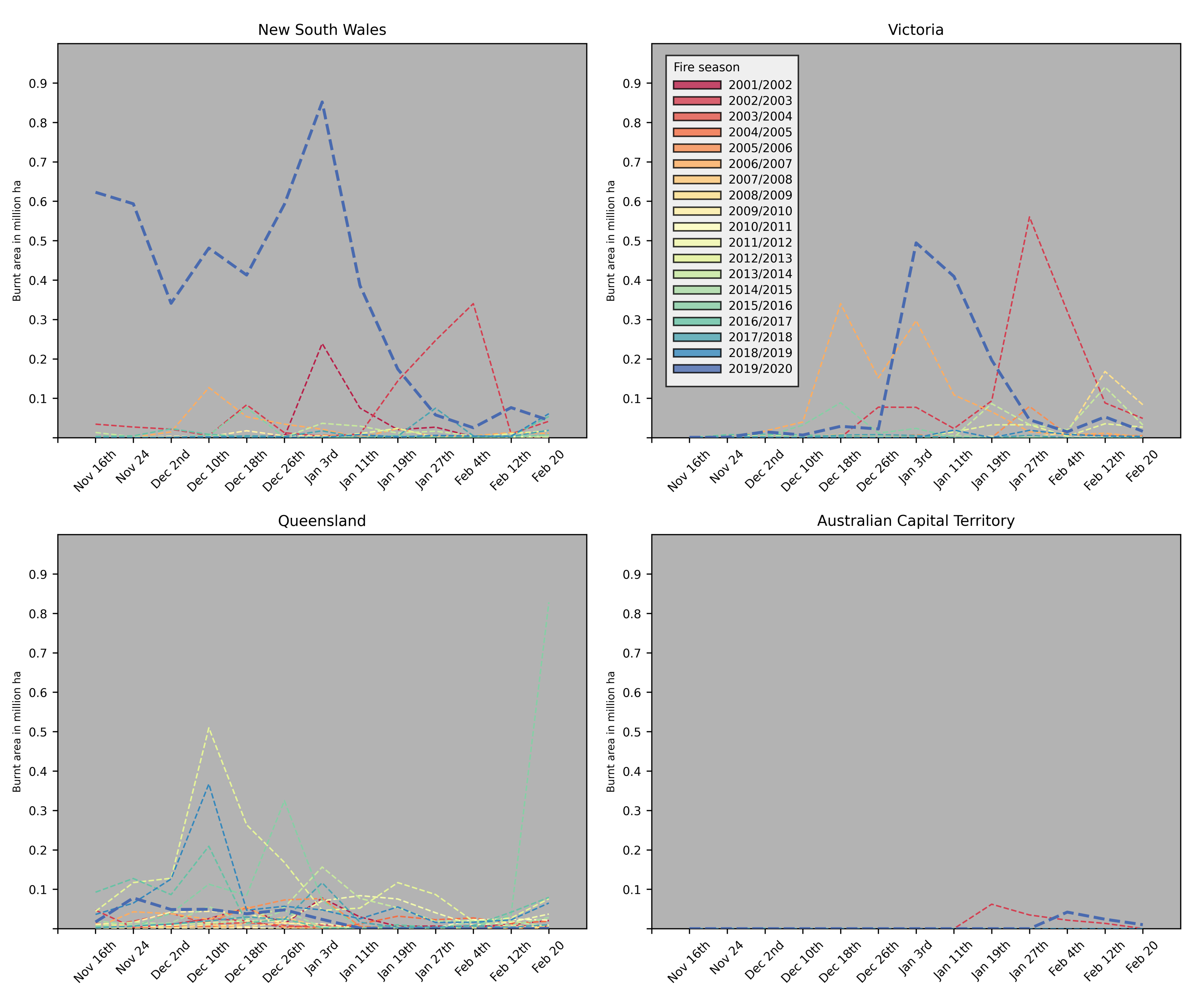
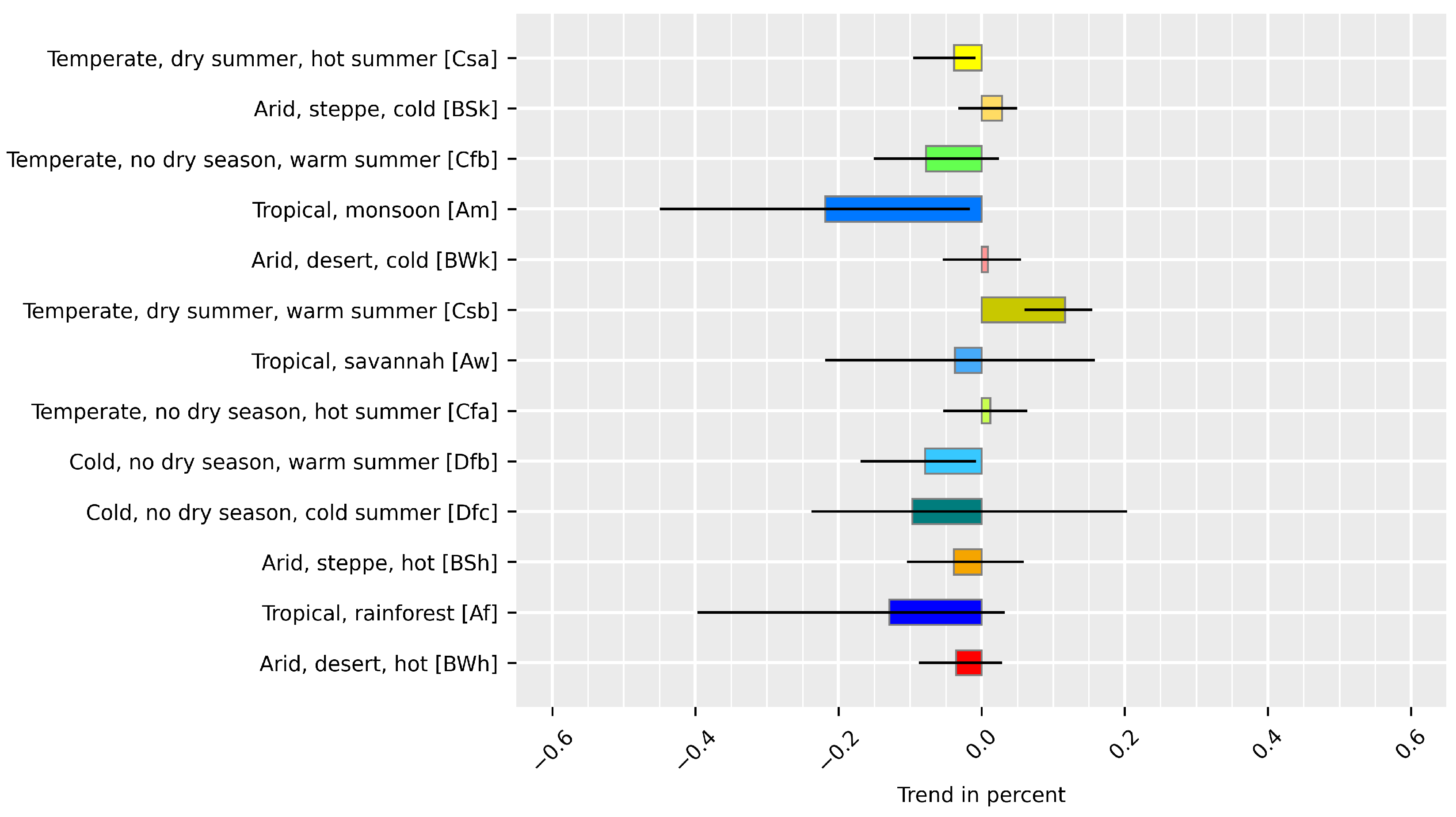
| Class | Slope (%) | Perc 5 | Perc 95 | Corr. Coef. | p-Value | RMSE | Label |
|---|---|---|---|---|---|---|---|
| Csa | −0.038 | −0.093 | −0.010 | −0.141 | 0.55 | 0.015 | Temperate, dry summer, hot summer |
| BSk | 0.028 | −0.030 | 0.047 | 0.158 | 0.51 | 0.010 | Arid, steppe, cold |
| Cfb | −0.077 | −0.148 | 0.022 | −0.135 | 0.57 | 0.032 | Temperate, no dry season, warm summer |
| Am | −0.218 | −0.447 | −0.018 | −0.142 | 0.55 | 0.087 | Tropical, monsoon |
| BWk | 0.008 | −0.052 | 0.053 | 0.048 | 0.84 | 0.010 | Arid, desert, cold |
| Csb | 0.116 | 0.061 | 0.152 | 0.292 | 0.21 | 0.022 | Temperate, dry summer, warm summer |
| Aw | −0.037 | −0.216 | 0.156 | −0.029 | 0.9 | 0.072 | Tropical, savannah |
| Cfa | 0.012 | −0.051 | 0.061 | 0.028 | 0.91 | 0.025 | Temperate, no dry season, hot summer |
| Dfb | −0.079 | −0.167 | −0.009 | −0.109 | 0.65 | 0.041 | Cold, no dry season, warm summer |
| Dfc | −0.096 | −0.235 | 0.201 | −0.111 | 0.64 | 0.050 | Cold, no dry season, cold summer |
| BSh | −0.038 | −0.102 | 0.057 | −0.072 | 0.76 | 0.030 | Arid, steppe, hot |
| Af | −0.129 | −0.395 | 0.030 | −0.079 | 0.74 | 0.094 | Tropical, rainforest |
| BWh | −0.035 | −0.085 | 0.027 | −0.125 | 0.6 | 0.016 | Arid, desert, hot |
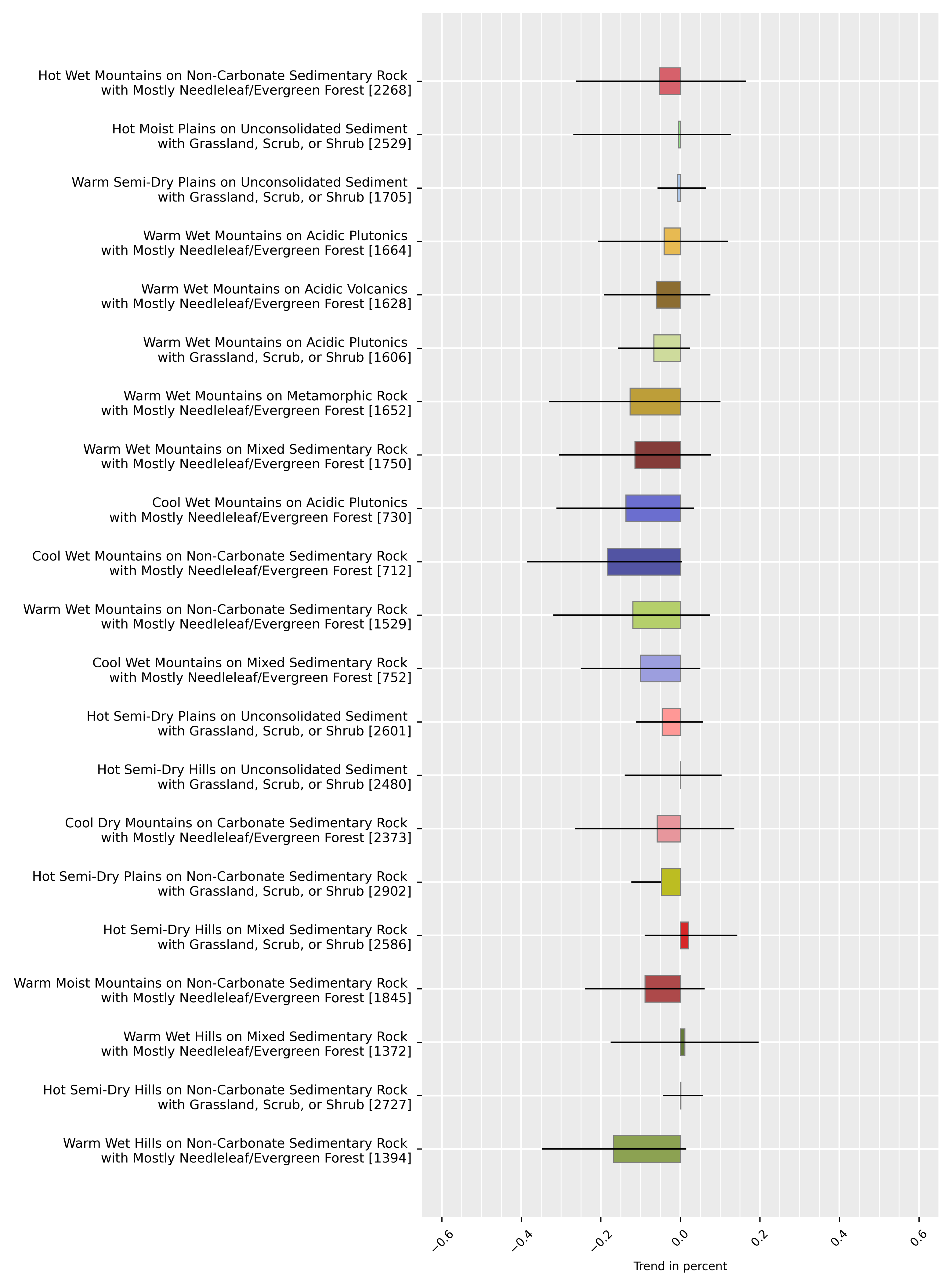
| Class | Slope (%) | Perc 5 | Perc 95 | Corr. Coef. | p-Value | RMSE | Label |
|---|---|---|---|---|---|---|---|
| 2268 | 0.263 | 0.150 | 0.373 | 0.456 | 0.04 | 0.029 | Hot Wet Mountains on Non-Carbonate Sedimentary Rock with Mostly Needleleaf/Evergreen Forest |
| 1712 | 0.058 | 0.028 | 0.089 | 0.418 | 0.07 | 0.007 | Warm Semi-Dry Plains on Unconsolidated Sediment with Mostly Cropland |
| 2529 | 0.108 | 0.029 | 0.229 | 0.17 | 0.47 | 0.036 | Hot Moist Plains on Unconsolidated Sediment with Grassland, Scrub, or Shrub |
| 1705 | −0.064 | −0.132 | 0.050 | −0.1 | 0.68 | 0.037 | Warm Semi-Dry Plains on Unconsolidated Sediment with Grassland, Scrub, or Shrub |
| 1664 | 0.652 | 0.265 | 0.998 | 0.357 | 0.12 | 0.098 | Warm Wet Mountains on Acidic Plutonics with Mostly Needleleaf/Evergreen Forest |
| 1628 | 0.184 | 0.063 | 0.294 | 0.329 | 0.15 | 0.030 | Warm Wet Mountains on Acidic Volcanics with Mostly Needleleaf/Evergreen Forest |
| 1606 | 0.072 | −0.015 | 0.160 | 0.189 | 0.42 | 0.021 | Warm Wet Mountains on Acidic Plutonics with Grassland, Scrub, or Shrub |
| 1734 | 0.095 | 0.038 | 0.150 | 0.371 | 0.10 | 0.013 | Warm Wet Mountains on Non-Acidic Volcanics with Mostly Needleleaf/Evergreen Forest |
| 1652 | 0.253 | 0.116 | 0.394 | 0.38 | 0.09 | 0.035 | Warm Wet Mountains on Metamorphic Rock with Mostly Needleleaf/Evergreen Forest |
| 1750 | 1.581 | 0.567 | 2.503 | 0.336 | 0.14 | 0.255 | Warm Wet Mountains on Mixed Sedimentary Rock with Mostly Needleleaf/Evergreen Forest |
| 730 | 0.108 | −0.103 | 0.321 | 0.109 | 0.64 | 0.056 | Cool Wet Mountains on Acidic Plutonics with Mostly Needleleaf/Evergreen Forest |
| 712 | −0.161 | −0.417 | 0.095 | −0.136 | 0.56 | 0.068 | Cool Wet Mountains on Non-Carbonate Sedimentary Rock with Mostly Needleleaf/Evergreen Forest |
| 1529 | 1.097 | 0.275 | 1.968 | 0.264 | 0.26 | 0.231 | Warm Wet Mountains on Non-Carbonate Sedimentary Rock with Mostly Needleleaf/Evergreen Forest |
| 752 | −0.023 | −0.311 | 0.274 | −0.017 | 0.94 | 0.079 | Cool Wet Mountains on Mixed Sedimentary Rock with Mostly Needleleaf/Evergreen Forest |
| 2601 | 0.759 | 0.132 | 1.083 | 0.248 | 0.29 | 0.171 | Hot Semi-Dry Plains on Unconsolidated Sediment with Grassland, Scrub, or Shrub |
| 2480 | 0.105 | 0.058 | 0.153 | 0.279 | 0.23 | 0.020 | Hot Semi-Dry Hills on Unconsolidated Sediment with Grassland, Scrub, or Shrub |
| 2373 | 0.231 | 0.111 | 0.355 | 0.38 | 0.09 | 0.032 | Cool Dry Mountains on Carbonate Sedimentary Rock with Mostly Needleleaf/Evergreen Forest |
| 2902 | 0.068 | 0.015 | 0.083 | 0.405 | 0.08 | 0.008 | Hot Semi-Dry Plains on Non-Carbonate Sedimentary Rock with Grassland, Scrub, or Shrub |
| 2621 | 0.050 | 0.030 | 0.093 | 0.273 | 0.24 | 0.010 | Hot Semi-Dry Plains on Unconsolidated Sediment with Sparse Vegetation |
| 2711 | 4.196 | −0.001 | 0.002 | 0.259 | 0.27 | 0.000 | Hot Dry Plains on Unconsolidated Sediment with Bare area |
| 2586 | 0.106 | 0.043 | 0.165 | 0.313 | 0.18 | 0.018 | Hot Semi-Dry Hills on Mixed Sedimentary Rock with Grassland, Scrub, or Shrub |
| 2606 | 0.003 | −0.006 | 0.018 | 0.072 | 0.76 | 0.002 | Hot Semi-Dry Plains on Mixed Sedimentary Rock with Sparse Vegetation |
| 1845 | 0.222 | 0.074 | 0.359 | 0.3 | 0.19 | 0.040 | Warm Moist Mountains on Non-Carbonate Sedimentary Rock with Mostly Needleleaf/Evergreen Forest |
| 2614 | 0.019 | 0.012 | 0.031 | 0.337 | 0.15 | 0.003 | Hot Semi-Dry Plains on Mixed Sedimentary Rock with Grassland, Scrub, or Shrub |
| 1372 | 0.151 | 0.066 | 0.232 | 0.378 | 0.10 | 0.021 | Warm Wet Hills on Mixed Sedimentary Rock with Mostly Needleleaf/Evergreen Forest |
| 2822 | 4.034 | −0.003 | 0.001 | 0.061 | 0.8 | 0.000 | Hot Dry Plains on Unconsolidated Sediment with Sparse Vegetation |
| 2784 | −0.000 | −0.007 | 0.004 | −0.06 | 0.8 | 0.000 | Hot Semi-Dry Plains on Non-Carbonate Sedimentary Rock with Sparse Vegetation |
| 1849 | −0.019 | −0.028 | −0.007 | −0.307 | 0.19 | 0.003 | Warm Semi-Dry Plains on Unconsolidated Sediment with Sparse Vegetation |
| 2727 | 0.146 | 0.092 | 0.277 | 0.255 | 0.28 | 0.032 | Hot Semi-Dry Hills on Non-Carbonate Sedimentary Rock with Grassland, Scrub, or Shrub |
| 2791 | 0.008 | 0.007 | 0.033 | 0.085 | 0.72 | 0.005 | Hot Dry Plains on Unconsolidated Sediment with Swampy or Often Flooded Vegetation |
| 1394 | 0.024 | −0.103 | 0.140 | 0.045 | 0.84 | 0.031 | Warm Wet Hills on Non-Carbonate Sedimentary Rock with Mostly Needleleaf/Evergreen Forest |
| Class | Slope (%) | Perc 5 | Perc 95 | Corr. Coef. | p-Value | RMSE | Label |
|---|---|---|---|---|---|---|---|
| 2268 | 0.385 | 0.269 | 0.499 | 0.589 | 0.006 | 0.030 | Hot Wet Mountains on Non-Carbonate Sedimentary Rock with Mostly Needleleaf/Evergreen Forest |
| 1712 | 0.326 | 0.177 | 0.453 | 0.385 | 0.09 | 0.045 | Warm Semi-Dry Plains on Unconsolidated Sediment with Mostly Cropland |
| 2529 | 0.314 | 0.251 | 0.360 | 0.519 | 0.019 | 0.029 | Hot Moist Plains on Unconsolidated Sediment with Grassland, Scrub, or Shrub |
| 1705 | 0.283 | 0.232 | 0.413 | 0.341 | 0.14 | 0.044 | Warm Semi-Dry Plains on Unconsolidated Sediment with Grassland, Scrub, or Shrub |
| 1664 | 0.271 | 0.063 | 0.480 | 0.277 | 0.236 | 0.054 | Warm Wet Mountains on Acidic Plutonics with Mostly Needleleaf/Evergreen Forest |
| 1628 | 0.262 | 0.100 | 0.429 | 0.318 | 0.171 | 0.045 | Warm Wet Mountains on Acidic Volcanics with Mostly Needleleaf/Evergreen Forest |
| 1606 | 0.234 | 0.056 | 0.404 | 0.269 | 0.251 | 0.048 | Warm Wet Mountains on Acidic Plutonics with Grassland, Scrub, or Shrub |
| 1734 | 0.224 | 0.052 | 0.407 | 0.259 | 0.269 | 0.048 | Warm Wet Mountains on Non-Acidic Volcanics with Mostly Needleleaf/Evergreen Forest |
| 1652 | 0.224 | 0.120 | 0.326 | 0.45 | 0.046 | 0.025 | Warm Wet Mountains on Metamorphic Rock with Mostly Needleleaf/Evergreen Forest |
| 1750 | 0.179 | −0.038 | 0.418 | 0.161 | 0.498 | 0.063 | Warm Wet Mountains on Mixed Sedimentary Rock with Mostly Needleleaf/Evergreen Forest |
| 730 | 0.173 | −0.012 | 0.378 | 0.179 | 0.450 | 0.055 | Cool Wet Mountains on Acidic Plutonics with Mostly Needleleaf/Evergreen Forest |
| 712 | 0.163 | −0.069 | 0.393 | 0.148 | 0.533 | 0.062 | Cool Wet Mountains on Non-Carbonate Sedimentary Rock with Mostly Needleleaf/Evergreen Forest |
| 1529 | 0.158 | −0.053 | 0.374 | 0.158 | 0.504 | 0.057 | Warm Wet Mountains on Non-Carbonate Sedimentary Rock with Mostly Needleleaf/Evergreen Forest |
| 752 | 0.142 | −0.076 | 0.344 | 0.145 | 0.543 | 0.056 | Cool Wet Mountains on Mixed Sedimentary Rock with Mostly Needleleaf/Evergreen Forest |
| 2601 | 0.127 | 0.113 | 0.265 | 0.212 | 0.37 | 0.034 | Hot Semi-Dry Plains on Unconsolidated Sediment with Grassland, Scrub, or Shrub |
| 2480 | 0.114 | −0.029 | 0.298 | 0.176 | 0.46 | 0.037 | Hot Semi-Dry Hills on Unconsolidated Sediment with Grassland, Scrub, or Shrub |
| 2373 | 0.107 | −0.004 | 0.213 | 0.217 | 0.357 | 0.027 | Cool Dry Mountains on Carbonate Sedimentary Rock with Mostly Needleleaf/Evergreen Forest |
| 2902 | 0.061 | −0.004 | 0.225 | 0.089 | 0.71 | 0.039 | Hot Semi-Dry Plains on Non-Carbonate Sedimentary Rock with Grassland, Scrub, or Shrub |
| 2621 | 0.056 | −0.060 | 0.138 | 0.113 | 0.64 | 0.028 | Hot Semi-Dry Plains on Unconsolidated Sediment with Sparse Vegetation |
| 2711 | 0.035 | 0.005 | 0.062 | 0.259 | 0.27 | 0.007 | Hot Dry Plains on Unconsolidated Sediment with Bare area |
| 2586 | 0.031 | −0.106 | 0.057 | 0.05 | 0.83 | 0.036 | Hot Semi-Dry Hills on Mixed Sedimentary Rock with Grassland, Scrub, or Shrub |
| 2606 | 0.022 | −0.022 | 0.128 | 0.054 | 0.82 | 0.024 | Hot Semi-Dry Plains on Mixed Sedimentary Rock with Sparse Vegetation |
| 1845 | 0.017 | −0.152 | 0.199 | 0.023 | 0.924 | 0.045 | Warm Moist Mountains on Non-Carbonate Sedimentary Rock with Mostly Needleleaf/Evergreen Forest |
| 2614 | 0.010 | −0.121 | 0.066 | 0.019 | 0.94 | 0.033 | Hot Semi-Dry Plains on Mixed Sedimentary Rock with Grassland, Scrub, or Shrub |
| 1372 | 0.005 | −0.174 | 0.194 | 0.007 | 0.977 | 0.046 | Warm Wet Hills on Mixed Sedimentary Rock with Mostly Needleleaf/Evergreen Forest |
| 2822 | −0.018 | −0.019 | 0.006 | −0.094 | 0.69 | 0.011 | Hot Dry Plains on Unconsolidated Sediment with Sparse Vegetation |
| 2784 | −0.028 | −0.122 | 0.074 | −0.066 | 0.78 | 0.025 | Hot Semi-Dry Plains on Non-Carbonate Sedimentary Rock with Sparse Vegetation |
| 1849 | −0.078 | −0.140 | 0.047 | −0.15 | 0.53 | 0.029 | Warm Semi-Dry Plains on Unconsolidated Sediment with Sparse Vegetation |
| 2727 | −0.118 | −0.185 | 0.037 | −0.211 | 0.37 | 0.031 | Hot Semi-Dry Hills on Non-Carbonate Sedimentary Rock with Grassland, Scrub, or Shrub |
| 2791 | −0.123 | −0.298 | −0.087 | −0.22 | 0.35 | 0.031 | Hot Dry Plains on Unconsolidated Sediment with Swampy or Often Flooded Vegetation |
| 1394 | −0.231 | −0.457 | −0.009 | −0.218 | 0.355 | 0.059 | Warm Wet Hills on Non-Carbonate Sedimentary Rock with Mostly Needleleaf/Evergreen Forest |
| Class | Slope (%) | Perc 5 | Perc 95 | Corr. Coef. | p-Value | RMSE | Label |
|---|---|---|---|---|---|---|---|
| 2268 | −0.052 | −0.259 | 0.163 | −0.053 | 0.824 | 0.057 | Hot Wet Mountains on Non-Carbonate Sedimentary Rock with Mostly Needleleaf/Evergreen Forest |
| 1712 | 0.012 | −0.006 | 0.039 | 0.081 | 0.73 | 0.008 | Warm Semi-Dry Plains on Unconsolidated Sediment with Mostly Cropland |
| 2529 | −0.004 | −0.267 | 0.124 | −0.003 | 0.99 | 0.070 | Hot Moist Plains on Unconsolidated Sediment with Grassland, Scrub, or Shrub |
| 1705 | −0.007 | −0.055 | 0.062 | −0.034 | 0.89 | 0.012 | Warm Semi-Dry Plains on Unconsolidated Sediment with Grassland, Scrub, or Shrub |
| 1664 | −0.040 | −0.204 | 0.118 | −0.055 | 0.818 | 0.042 | Warm Wet Mountains on Acidic Plutonics with Mostly Needleleaf/Evergreen Forest |
| 1628 | −0.060 | −0.190 | 0.073 | −0.099 | 0.679 | 0.034 | Warm Wet Mountains on Acidic Volcanics with Mostly Needleleaf/Evergreen Forest |
| 1606 | −0.066 | −0.154 | 0.022 | −0.166 | 0.484 | 0.022 | Warm Wet Mountains on Acidic Plutonics with Grassland, Scrub, or Shrub |
| 1734 | −0.110 | −0.257 | 0.030 | −0.159 | 0.501 | 0.039 | Warm Wet Mountains on Non-Acidic Volcanics with Mostly Needleleaf/Evergreen Forest |
| 1652 | −0.126 | −0.328 | 0.099 | −0.125 | 0.600 | 0.057 | Warm Wet Mountains on Metamorphic Rock with Mostly Needleleaf/Evergreen Forest |
| 1750 | −0.113 | −0.303 | 0.075 | −0.13 | 0.586 | 0.050 | Warm Wet Mountains on Mixed Sedimentary Rock with Mostly Needleleaf/Evergreen Forest |
| 730 | −0.136 | −0.309 | 0.032 | −0.171 | 0.469 | 0.045 | Cool Wet Mountains on Acidic Plutonics with Mostly Needleleaf/Evergreen Forest |
| 712 | −0.182 | −0.383 | 0.002 | −0.2 | 0.397 | 0.051 | Cool Wet Mountains on Non-Carbonate Sedimentary Rock with Mostly Needleleaf/Evergreen Forest |
| 1529 | −0.119 | −0.317 | 0.073 | −0.134 | 0.573 | 0.050 | Warm Wet Mountains on Non-Carbonate Sedimentary Rock with Mostly Needleleaf/Evergreen Forest |
| 752 | −0.100 | −0.248 | 0.048 | −0.148 | 0.533 | 0.038 | Cool Wet Mountains on Mixed Sedimentary Rock with Mostly Needleleaf/Evergreen Forest |
| 2601 | −0.044 | −0.109 | 0.055 | −0.089 | 0.71 | 0.028 | Hot Semi-Dry Plains on Unconsolidated Sediment with Grassland, Scrub, or Shrub |
| 2480 | 0.000 | −0.137 | 0.102 | 0.001 | 1.0 | 0.033 | Hot Semi-Dry Hills on Unconsolidated Sediment with Grassland, Scrub, or Shrub |
| 2373 | −0.058 | −0.262 | 0.134 | −0.061 | 0.799 | 0.055 | Cool Dry Mountains on Carbonate Sedimentary Rock with Mostly Needleleaf/Evergreen Forest |
| 2902 | −0.047 | −0.121 | −0.049 | −0.112 | 0.64 | 0.024 | Hot Semi-Dry Plains on Non-Carbonate Sedimentary Rock with Grassland, Scrub, or Shrub |
| 2621 | −0.054 | −0.193 | 0.092 | −0.093 | 0.7 | 0.033 | Hot Semi-Dry Plains on Unconsolidated Sediment with Sparse Vegetation |
| 2711 | −0.013 | −0.051 | 0.036 | −0.062 | 0.8 | 0.012 | Hot Dry Plains on Unconsolidated Sediment with Bare area |
| 2586 | 0.021 | −0.087 | 0.141 | 0.042 | 0.86 | 0.029 | Hot Semi-Dry Hills on Mixed Sedimentary Rock with Grassland, Scrub, or Shrub |
| 2606 | −0.090 | −0.250 | 0.047 | −0.109 | 0.65 | 0.047 | Hot Semi-Dry Plains on Mixed Sedimentary Rock with Sparse Vegetation |
| 1845 | −0.088 | −0.237 | 0.059 | −0.123 | 0.605 | 0.041 | Warm Moist Mountains on Non-Carbonate Sedimentary Rock with Mostly Needleleaf/Evergreen Forest |
| 2614 | −0.050 | −0.147 | 0.094 | −0.086 | 0.72 | 0.033 | Hot Semi-Dry Plains on Mixed Sedimentary Rock with Grassland, Scrub, or Shrub |
| 1372 | 0.011 | −0.173 | 0.195 | 0.014 | 0.954 | 0.048 | Warm Wet Hills on Mixed Sedimentary Rock with Mostly Needleleaf/Evergreen Forest |
| 2822 | −0.025 | −0.071 | 0.037 | −0.096 | 0.69 | 0.015 | Hot Dry Plains on Unconsolidated Sediment with Sparse Vegetation |
| 2784 | −0.096 | −0.196 | 0.024 | −0.167 | 0.48 | 0.032 | Hot Semi-Dry Plains on Non-Carbonate Sedimentary Rock with Sparse Vegetation |
| 1849 | −0.012 | −0.035 | 0.008 | −0.093 | 0.7 | 0.007 | Warm Semi-Dry Plains on Unconsolidated Sediment with Sparse Vegetation |
| 2727 | 0.001 | −0.040 | 0.054 | 0.002 | 0.99 | 0.031 | Hot Semi-Dry Hills on Non-Carbonate Sedimentary Rock with Grassland, Scrub, or Shrub |
| 2791 | −0.261 | −0.350 | −0.164 | −0.319 | 0.17 | 0.044 | Hot Dry Plains on Unconsolidated Sediment with Swampy or Often Flooded Vegetation |
| 1394 | −0.167 | −0.346 | 0.013 | −0.194 | 0.413 | 0.049 | Warm Wet Hills on Non-Carbonate Sedimentary Rock with Mostly Needleleaf/Evergreen Forest |
References
- Bowman, D.M.; Balch, J.K.; Artaxo, P.; Bond, W.J.; Carlson, J.M.; Cochrane, M.A.; D’Antonio, C.M.; DeFries, R.S.; Doyle, J.C.; Harrison, S.P.; et al. Fire in the Earth system. Science 2009, 324, 481–484. [Google Scholar] [CrossRef]
- Withey, K.; Berenguer, E.; Palmeira, A.F.; Espírito-Santo, F.D.; Lennox, G.D.; Silva, C.V.; Aragão, L.E.; Ferreira, J.; França, F.; Malhi, Y.; et al. Quantifying immediate carbon emissions from El Niño-mediated wildfires in humid tropical forests. Philos. Trans. R. Soc. B Biol. Sci. 2018, 373, 20170312. [Google Scholar] [CrossRef] [Green Version]
- Surawski, N.; Sullivan, A.; Roxburgh, S.; Polglase, P. Estimates of greenhouse gas and black carbon emissions from a major Australian wildfire with high spatiotemporal resolution. J. Geophys. Res. Atmos. 2016, 121, 9892–9907. [Google Scholar] [CrossRef]
- Van Wees, D.; van der Werf, G. The contribution of fire to a global increase in forest loss. In Proceedings of the EGU General Assembly Conference Abstracts, Online, 4–8 May 2020; p. 18049. [Google Scholar]
- Girardin, M.P.; Mudelsee, M. Past and future changes in Canadian boreal wildfire activity. Ecol. Appl. 2008, 18, 391–406. [Google Scholar] [CrossRef] [PubMed]
- Miller, J.D.; Safford, H.; Crimmins, M.; Thode, A.E. Quantitative evidence for increasing forest fire severity in the Sierra Nevada and southern Cascade Mountains, California and Nevada, USA. Ecosystems 2009, 12, 16–32. [Google Scholar] [CrossRef]
- Werf, G.v.d.; Randerson, J.; Giglio, L.; Wees, D.v.; Andela, N.; Veraverbeke, S.; Morton, D.; Chen, Y. Fire-climate interactions in a warming world. In Proceedings of the EGU General Assembly Conference Abstracts, Online, 4–8 May 2020; p. 10974. [Google Scholar]
- Giglio, L.; Justice, C.; Boschetti, L.; Roy, D. MCD64A1 MODIS/Terra+Aqua Burned Area Monthly l3 Global 500 m Sin Grid v006 [Data Set]. 2015. Available online: https://doi.org/10.5067/MODIS/MCD64A1.006 (accessed on 5 October 2020). [CrossRef]
- Lizundia-Loiola, J.; Otón, G.; Ramo, R.; Chuvieco, E. A spatio-temporal active-fire clustering approach for global burned area mapping at 250 m from MODIS data. Remote Sens. Environ. 2020, 236, 111493. [Google Scholar] [CrossRef]
- Chuvieco, E.; Yue, C.; Heil, A.; Mouillot, F.; Alonso-Canas, I.; Padilla, M.; Pereira, J.M.; Oom, D.; Tansey, K. A new global burned area product for climate assessment of fire impacts. Glob. Ecol. Biogeogr. 2016, 25, 619–629. [Google Scholar] [CrossRef] [Green Version]
- Giglio, L.; Randerson, J.T.; Van Der Werf, G.R. Analysis of daily, monthly, and annual burned area using the fourth-generation global fire emissions database (GFED4). J. Geophys. Res. Biogeosci. 2013, 118, 317–328. [Google Scholar] [CrossRef] [Green Version]
- Global Fire Emissions Database (GFED). GFED Data. 2020. Available online: ftp://fuoco.geog.umd.edu (accessed on 4 October 2020).
- San-Miguel-Ayanz, J.; Schulte, E.; Schmuck, G.; Camia, A.; Strobl, P.; Liberta, G.; Giovando, C.; Boca, R.; Sedano, F.; Kempeneers, P.; et al. Comprehensive monitoring of wildfires in Europe: The European Forest Fire Information System (EFFIS). In Approaches to Managing Disaster-Assessing Hazards, Emergencies and Disaster Impacts; IntechOpen: London, UK, 2012. [Google Scholar]
- Joint Research Center of the European Commission (JRC). Welcome to EFFIS. 2020. Available online: https://effis.jrc.ec.europa.eu (accessed on 5 June 2020).
- Tran, B.N.; Tanase, M.A.; Bennett, L.T.; Aponte, C. High-severity wildfires in temperate Australian forests have increased in extent and aggregation in recent decades. PLoS ONE 2020, 15, e0242484. [Google Scholar] [CrossRef] [PubMed]
- Nolde, M.; Plank, S.; Riedlinger, T. An Adaptive and Extensible System for Satellite-Based, Large Scale Burnt Area Monitoring in Near-Real Time. Remote Sens. 2020, 12, 2162. [Google Scholar] [CrossRef]
- MOD09A1 MODIS/Terra Surface Reflectance 8-Day l3 Global 500 m Sin Grid v006 [Data Set]. 2015. Available online: https://doi.org/10.5067/MODIS/MOD09Q1.006 (accessed on 15 September 2020). [CrossRef]
- Australian Government Bureau of Meteorology (BoM). Annual Climate Statement 2019. 2020. Available online: http://www.bom.gov.au/climate/current/annual/aus/#tabs=Overview (accessed on 1 November 2020).
- Australian National University (ANU). Australia’s Environment Summary Report 2019. 2020. Available online: https://www.wenfo.org/aer/wp-content/uploads/2020/03/AustraliasEnvironment_2019_SummaryReport.pdf (accessed on 2 November 2020).
- Australian Government Bureau of Meteorology (BoM). Climate Monitoring Graphs. 2020. Available online: http://www.bom.gov.au/climate/enso/indices.shtml?bookmark=iod (accessed on 2 November 2020).
- Australian Government Bureau of Meteorology (BoM). Map of Climate Zones of Australia. 2020. Available online: http://www.bom.gov.au/climate/how/newproducts/images/zones.shtml (accessed on 2 November 2020).
- Beck, H.E.; Zimmermann, N.E.; McVicar, T.R.; Vergopolan, N.; Berg, A.; Wood, E.F. Present and future Köppen-Geiger climate classification maps at 1-km resolution. Sci. Data 2018, 5, 180214. [Google Scholar] [CrossRef] [PubMed] [Green Version]
- Peel, M.C.; Finlayson, B.L.; McMahon, T.A. Updated world map of the Köppen-Geiger climate classification. Hydrol. Earth Syst. Sci. 2007, 11, 1633–1644. [Google Scholar] [CrossRef] [Green Version]
- Luke, R.; McArthur, A. Bushfires in Australia, 2nd ed.; Australian Government Publishing Service: Canberra, Australia, 1986.
- Dowdy, A.J.; Mills, G.A.; Finkele, K.; de Groot, W. Australian fire weather as represented by the McArthur forest fire danger index and the Canadian forest fire weather index. Cent. Aust. Weather Clim. Res. Tech. Rep. 2009, 10, 91. [Google Scholar]
- Russell-Smith, J.; Yates, C.P.; Whitehead, P.J.; Smith, R.; Craig, R.; Allan, G.E.; Thackway, R.; Frakes, I.; Cridland, S.; Meyer, M.C.; et al. Bushfires ‘down under’: Patterns and implications of contemporary Australian landscape burning. Int. J. Wildland Fire 2007, 16, 361–377. [Google Scholar] [CrossRef]
- Allan, G.E.; Southgate, R.I. Fire regimes in the spinifex landscapes of Australia. In Flammable Australia: The Fire Regimes and Biodiversity of a Continent; Cambridge University Press: Cambridge, UK, 2002; pp. 145–176. [Google Scholar]
- Bradstock, R.A. A biogeographic model of fire regimes in Australia: Current and future implications. Glob. Ecol. Biogeogr. 2010, 19, 145–158. [Google Scholar] [CrossRef]
- Ellis, S.; Kanowski, P.; Whelan, R. National Inquiry on Bushfire Mitigation and Management; Council of Australian Governments: Canberra, Australia, 2004.
- Verdon, D.C.; Kiem, A.S.; Franks, S.W. Multi-decadal variability of forest fire risk—Eastern Australia. Int. J. Wildland Fire 2004, 13, 165–171. [Google Scholar] [CrossRef]
- European Space Agency (ESA). Sentinel-3 OLCI Introduction. 2020. Available online: https://sentinel.esa.int/web/sentinel/user-guides/sentinel-3-olci (accessed on 10 June 2020).
- European Space Agency (ESA). Copernicus Open Access Hub. 2020. Available online: https://scihub.copernicus.eu (accessed on 10 June 2020).
- EUMETSAT. Copernicus Online Data Access. 2020. Available online: https://coda.eumetsat.int/#/home (accessed on 15 August 2020).
- National Aeronautics and Space Administration (NASA). MODIS—Moderate Resolution Imaging Spectroradiometer. 2020. Available online: https://terra.nasa.gov/about/terra-instruments/modis (accessed on 8 April 2020).
- National Aeronautics and Space Administration (NASA). NASA Land Processes Distributed Active Archive Center (LP DAAC). 2020. Available online: http://e4ftl01.cr.usgs.gov (accessed on 8 April 2020).
- Giglio, L.; Justice, C. MOD14A2 MODIS/Terra Thermal Anomalies/Fire 8-Day l3 Global 1 km Sin Grid v006 [Data Set]. 2015. Available online: https://doi.org/10.5067/MODIS/MOD14A2.006 (accessed on 8 April 2020). [CrossRef]
- Schroeder, W.; Giglio, L. VIIRS/NPP Thermal Anomalies/Fire Daily l3 Global 1 km Sin Grid v001 [Data Set]. 2017. Available online: https://doi.org/10.5067/VIIRS/VNP14A1.001 (accessed on 15 May 2020). [CrossRef]
- National Aeronautics and Space Administration (NASA). Fire Information for Resource Management System (FIRMS). 2020. Available online: https://firms.modaps.eosdis.nasa.gov (accessed on 17 May 2020).
- European Space Agency (ESA). Land Cover Classification Gridded Maps from 1992 to Present Derived from Satellite Observations. 2020. Available online: https://cds.climate.copernicus.eu/cdsapp#!/dataset/satellite-land-cover?tab=overview (accessed on 17 January 2020).
- Sayre, R.; Dangermond, J.; Frye, C.; Vaughan, R.; Aniello, P.; Breyer, S.; Cribbs, D.; Hopkins, D.; Nauman, R.; Derrenbacher, W.; et al. A New Map of Global Ecological Land Units—An Ecophysiographic Stratification Approach; Association of American Geographers: Washington, DC, USA, 2014. [Google Scholar]
- University of Maryland/UMD. Archive Download. 2020. Available online: ftp://ba1.geog.umd.edu (accessed on 22 January 2020).
- Rodrigues, J.A.; Libonati, R.; Pereira, A.A.; Nogueira, J.M.; Santos, F.L.; Peres, L.F.; Santa Rosa, A.; Schroeder, W.; Pereira, J.M.; Giglio, L.; et al. How well do global burned area products represent fire patterns in the Brazilian Savannas biome? An accuracy assessment of the MCD64 collections. Int. J. Appl. Earth Obs. Geoinf. 2019, 78, 318–331. [Google Scholar] [CrossRef]
- Libonati, R.; DaCamara, C.C.; Setzer, A.W.; Morelli, F.; Melchiori, A.E. An algorithm for burned area detection in the Brazilian Cerrado using 4 μm MODIS imagery. Remote Sens. 2015, 7, 15782–15803. [Google Scholar] [CrossRef] [Green Version]
- Department of Planning, Industry and Environment of New South Wales (DPIE). Google Earth Engine Burnt Area Map (GEEBAM). 2020. Available online: https://datasets.seed.nsw.gov.au/dataset/google-earth-engine-burnt-area-map-geebam (accessed on 10 September 2020).
- Department of Planning, Industry and Environment of New South Wales (DPIE). Google Earth Engine Burnt Area Map (GEEBAM)-Factsheet. 2020. Available online: https://datasets.seed.nsw.gov.au/dataset/f3c6e3da-f356-43f9-b8df-19c2e7fc004a/resource/a3f3f1a4-1758-4551-a005-a243fd26ec4b/download/geebamfactsheetmar2020.pdf (accessed on 11 September 2020).
- Australian Government. National Indicative Aggregated Fire Extent Datasets. 2021. Available online: https://data.gov.au/dataset/ds-environment-9ACDCB09-0364-4FE8-9459-2A56C792C743/details?q= (accessed on 10 September 2020).
- Roy, D.P.; Jin, Y.; Lewis, P.; Justice, C. Prototyping a global algorithm for systematic fire-affected area mapping using MODIS time series data. Remote Sens. Environ. 2005, 97, 137–162. [Google Scholar] [CrossRef]
- Zhang, H.K.; Roy, D.P.; Yan, L.; Li, Z.; Huang, H.; Vermote, E.; Skakun, S.; Roger, J.C. Characterization of Sentinel-2A and Landsat-8 top of atmosphere, surface, and nadir BRDF adjusted reflectance and NDVI differences. Remote Sens. Environ. 2018, 215, 482–494. [Google Scholar] [CrossRef]
- Ramo, R.; Chuvieco, E. Developing a Random Forest algorithm for MODIS global burned area classification. Remote Sens. 2017, 9, 1193. [Google Scholar] [CrossRef] [Green Version]
- Petropoulos, G.P.; Kontoes, C.; Keramitsoglou, I. Burnt area delineation from a uni-temporal perspective based on Landsat TM imagery classification using Support Vector Machines. Int. J. Appl. Earth Obs. Geoinf. 2011, 13, 70–80. [Google Scholar] [CrossRef]
- Pinto, M.M.; Libonati, R.; Trigo, R.M.; Trigo, I.F.; DaCamara, C.C. A deep learning approach for mapping and dating burned areas using temporal sequences of satellite images. ISPRS J. Photogramm. Remote Sens. 2020, 160, 260–274. [Google Scholar] [CrossRef]
- Knopp, L.; Wieland, M.; Rättich, M.; Martinis, S. A Deep Learning Approach for Burned Area Segmentation with Sentinel-2 Data. Remote Sens. 2020, 12, 2422. [Google Scholar] [CrossRef]
- Giglio, L.; Loboda, T.; Roy, D.P.; Quayle, B.; Justice, C.O. An active-fire based burned area mapping algorithm for the MODIS sensor. Remote Sens. Environ. 2009, 113, 408–420. [Google Scholar] [CrossRef]
- Humber, M.L.; Boschetti, L.; Giglio, L.; Justice, C.O. Spatial and temporal intercomparison of four global burned area products. Int. J. Digit. Earth 2019, 12, 460–484. [Google Scholar] [CrossRef] [PubMed]
- Padilla, M.; Stehman, S.V.; Ramo, R.; Corti, D.; Hantson, S.; Oliva, P.; Alonso-Canas, I.; Bradley, A.V.; Tansey, K.; Mota, B.; et al. Comparing the accuracies of remote sensing global burned area products using stratified random sampling and estimation. Remote Sens. Environ. 2015, 160, 114–121. [Google Scholar] [CrossRef] [Green Version]
- Oliva, P.; Schroeder, W. Assessment of VIIRS 375 m active fire detection product for direct burned area mapping. Remote Sens. Environ. 2015, 160, 144–155. [Google Scholar] [CrossRef]
- Rouse, J.W.; Haas, R.H.; Schell, J.A.; Deering, D.W.; Harlan, J.C. Monitoring the Vernal Advancement and Retrogradation (Green Wave Effect) of Natural Vegetation; NASA/GSFC Type III Final Report; NASA/GSFC: Greenbelt, MD, USA, 1974; Volume 371.
- Fraser, R.; Li, Z.; Cihlar, J. Hotspot and NDVI differencing synergy (HANDS): A new technique for burned area mapping over boreal forest. Remote Sens. Environ. 2000, 74, 362–376. [Google Scholar] [CrossRef]
- Li, Z.; Nadon, S.; Cihlar, J.; Stocks, B. Satellite-based mapping of Canadian boreal forest fires: Evaluation and comparison of algorithms. Int. J. Remote Sens. 2000, 21, 3071–3082. [Google Scholar] [CrossRef]
- Chan, T.; Vese, L. An active contour model without edges. In Proceedings of the International Conference on Scale-Space Theories in Computer Vision, Corfu, Greece, 26–27 September 1999; Springer: Berlin/Heidelberg, Germany, 1999; pp. 141–151. [Google Scholar]
- Chan, T.F.; Vese, L.A. Active contours without edges. IEEE Trans. Image Process. 2001, 10, 266–277. [Google Scholar] [CrossRef] [Green Version]
- Caselles, V.; Kimmel, R.; Sapiro, G. Geodesic active contours. In Proceedings of the IEEE International Conference on Computer Vision, Cambridge, MA, USA, 20–23 June 1995; IEEE: Piscataway, NJ, USA, 1995; pp. 694–699. [Google Scholar]
- Liu, Y.; Dai, Q.; Liu, J.; Liu, S.; Yang, J. Study of burn scar extraction automatically based on level set method using remote sensing data. PLoS ONE 2014, 9, e87480. [Google Scholar] [CrossRef] [PubMed]
- Yan, L.; Roy, D.P. Conterminous United States crop field size quantification from multi-temporal Landsat data. Remote Sens. Environ. 2016, 172, 67–86. [Google Scholar] [CrossRef] [Green Version]
- Plank, S.; Martinis, S. A fully automatic burnt area mapping processor based on AVHRR imagery—A timeline thematic processor. Remote Sens. 2018, 10, 341. [Google Scholar] [CrossRef] [Green Version]
- Jaccard, P. The distribution of the flora in the alpine zone. New Phytol. 1912, 11, 37–50. [Google Scholar] [CrossRef]
- Boer, M.M.; de Dios, V.R.; Bradstock, R.A. Unprecedented burn area of Australian mega forest fires. Nat. Clim. Chang. 2020, 10, 171–172. [Google Scholar] [CrossRef]
- Stocks, B.J.; Fosberg, M.; Lynham, T.; Mearns, L.; Wotton, B.; Yang, Q.; Jin, J.; Lawrence, K.; Hartley, G.; Mason, J.; et al. Climate change and forest fire potential in Russian and Canadian boreal forests. Clim. Chang. 1998, 38, 1–13. [Google Scholar] [CrossRef]
- Keeley, J.E. Fire intensity, fire severity and burn severity: A brief review and suggested usage. Int. J. Wildland Fire 2009, 18, 116–126. [Google Scholar] [CrossRef]
- Parks, S.A.; Holsinger, L.M.; Panunto, M.H.; Jolly, W.M.; Dobrowski, S.Z.; Dillon, G.K. High-severity fire: Evaluating its key drivers and mapping its probability across western US forests. Environ. Res. Lett. 2018, 13, 044037. [Google Scholar] [CrossRef]
- United States Geological Survey (USGS). Global Ecosystems Data. 2021. Available online: https://www.usgs.gov/centers/gecsc/science/global-ecosystems-data?qt-science_center_objects=0#qt-science_center_objects (accessed on 4 May 2021).
- Hammill, K.A.; Bradstock, R.A. Remote sensing of fire severity in the Blue Mountains: Influence of vegetation type and inferring fire intensity. Int. J. Wildland Fire 2006, 15, 213–226. [Google Scholar] [CrossRef]
- Escuin, S.; Navarro, R.; Fernandez, P. Fire severity assessment by using NBR (Normalized Burn Ratio) and NDVI (Normalized Difference Vegetation Index) derived from LANDSAT TM/ETM images. Int. J. Remote Sens. 2008, 29, 1053–1073. [Google Scholar] [CrossRef]
- Chen, X.; Vogelmann, J.E.; Rollins, M.; Ohlen, D.; Key, C.H.; Yang, L.; Huang, C.; Shi, H. Detecting post-fire burn severity and vegetation recovery using multitemporal remote sensing spectral indices and field-collected composite burn index data in a ponderosa pine forest. Int. J. Remote Sens. 2011, 32, 7905–7927. [Google Scholar] [CrossRef]
- Tran, B.N.; Tanase, M.A.; Bennett, L.T.; Aponte, C. Evaluation of spectral indices for assessing fire severity in Australian temperate forests. Remote Sens. 2018, 10, 1680. [Google Scholar] [CrossRef] [Green Version]
- Mathews, L.E.; Kinoshita, A.M. Urban Fire Severity and Vegetation Dynamics in Southern California. Remote Sens. 2021, 13, 19. [Google Scholar] [CrossRef]
- Storey, E.A.; Lee West, K.R.; Stow, D.A. Utility and optimization of LANDSAT-derived burned area maps for southern California. Int. J. Remote Sens. 2021, 42, 486–505. [Google Scholar] [CrossRef]
- Chafer, C.J. A comparison of fire severity measures: An Australian example and implications for predicting major areas of soil erosion. Catena 2008, 74, 235–245. [Google Scholar] [CrossRef]
- Collins, L.; Griffioen, P.; Newell, G.; Mellor, A. The utility of Random Forests for wildfire severity mapping. Remote Sens. Environ. 2018, 216, 374–384. [Google Scholar] [CrossRef]
- Collins, L.; McCarthy, G.; Mellor, A.; Newell, G.; Smith, L. Training data requirements for fire severity mapping using Landsat imagery and Random Forest. Remote Sens. Environ. 2020, 245, 111839. [Google Scholar] [CrossRef]
- United States Geological Survey/USGS. USGS EROS Archive—Advanced Very High Resolution Radiometer (AVHRR)—Sensor Characteristics. 2020. Available online: https://www.usgs.gov/centers/eros/science/usgs-eros-archive-advanced-very-high-resolution-radiometer-avhrr-sensor?qt-science_center_objects=0#qt-science_center_objects (accessed on 11 August 2021).
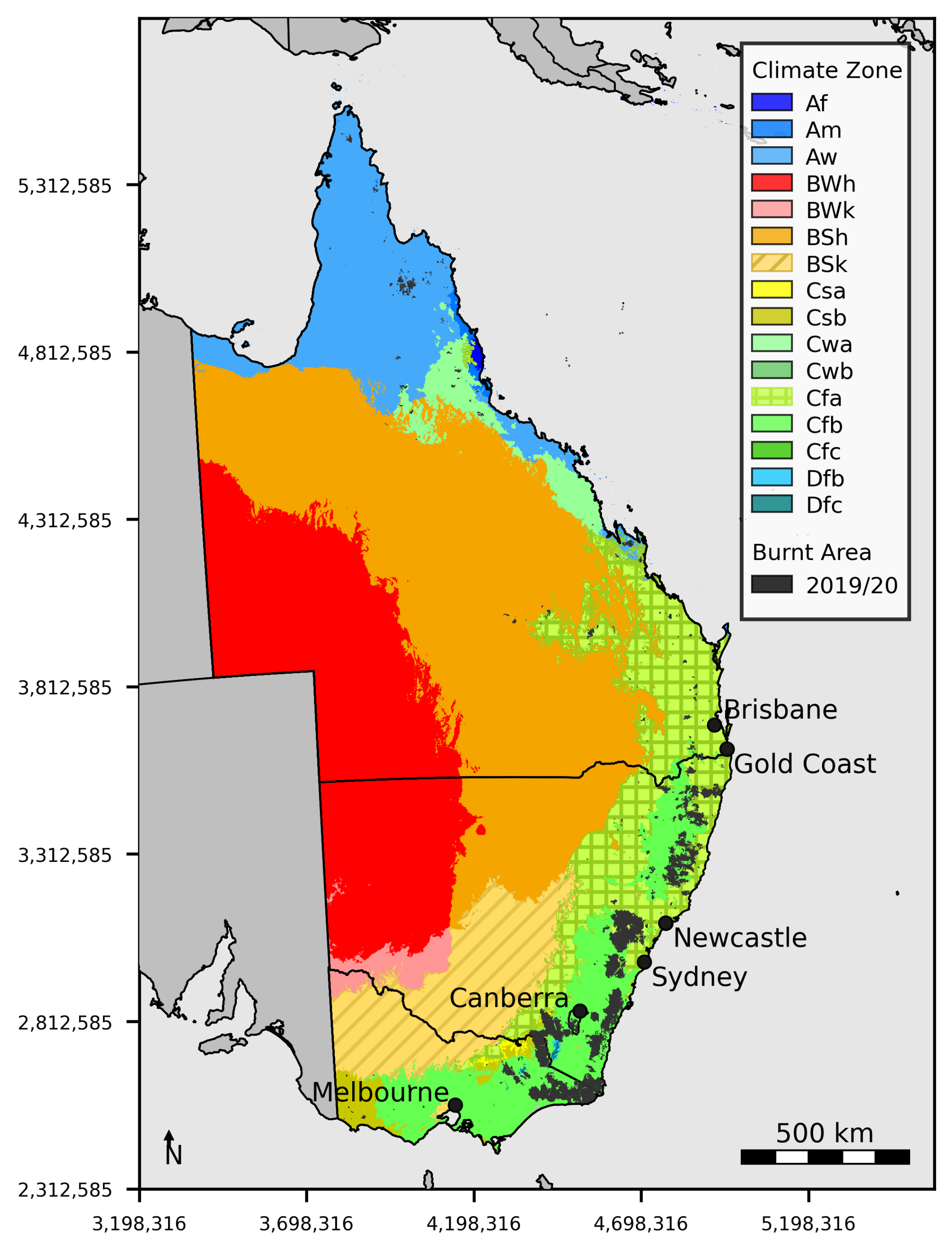
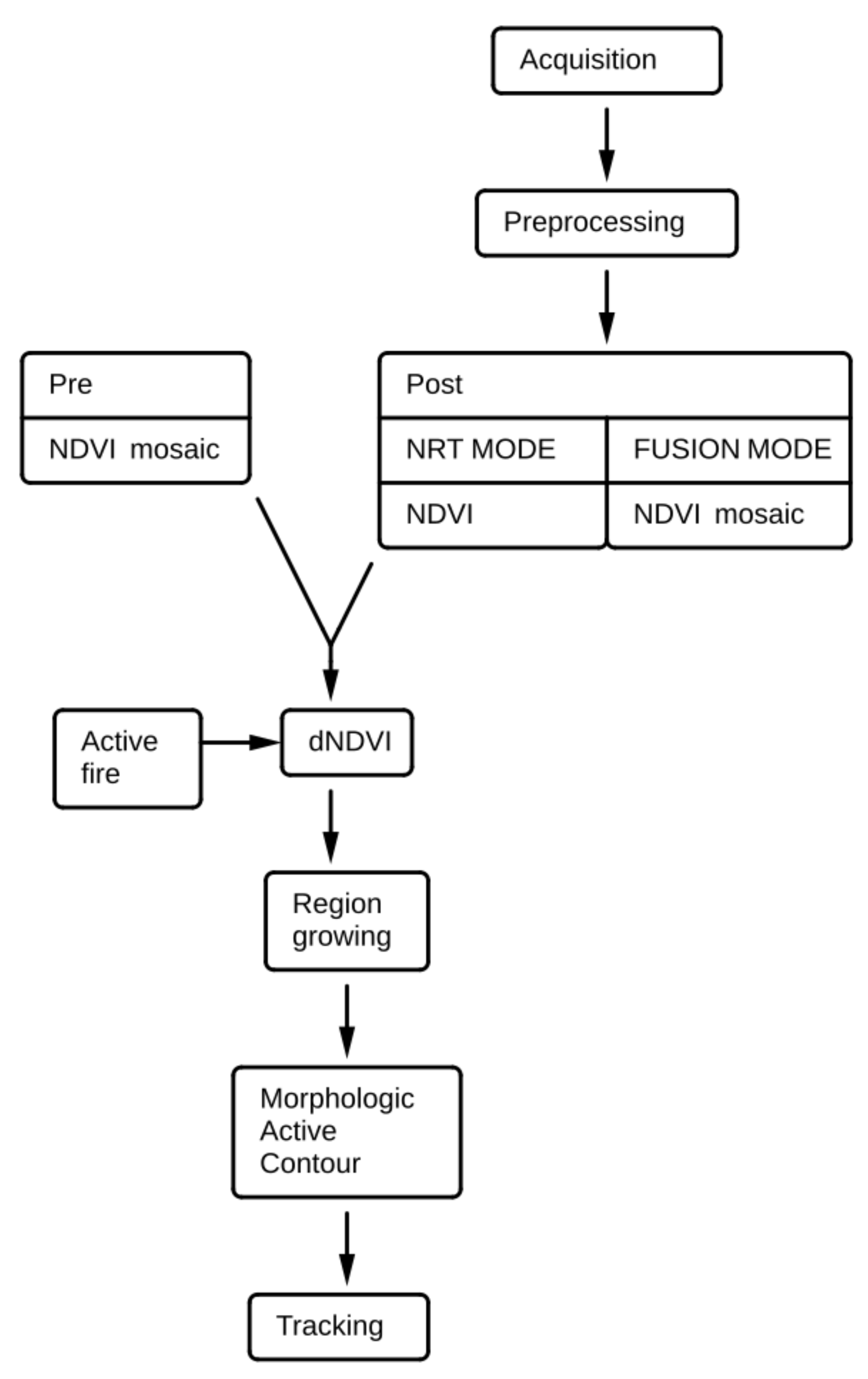
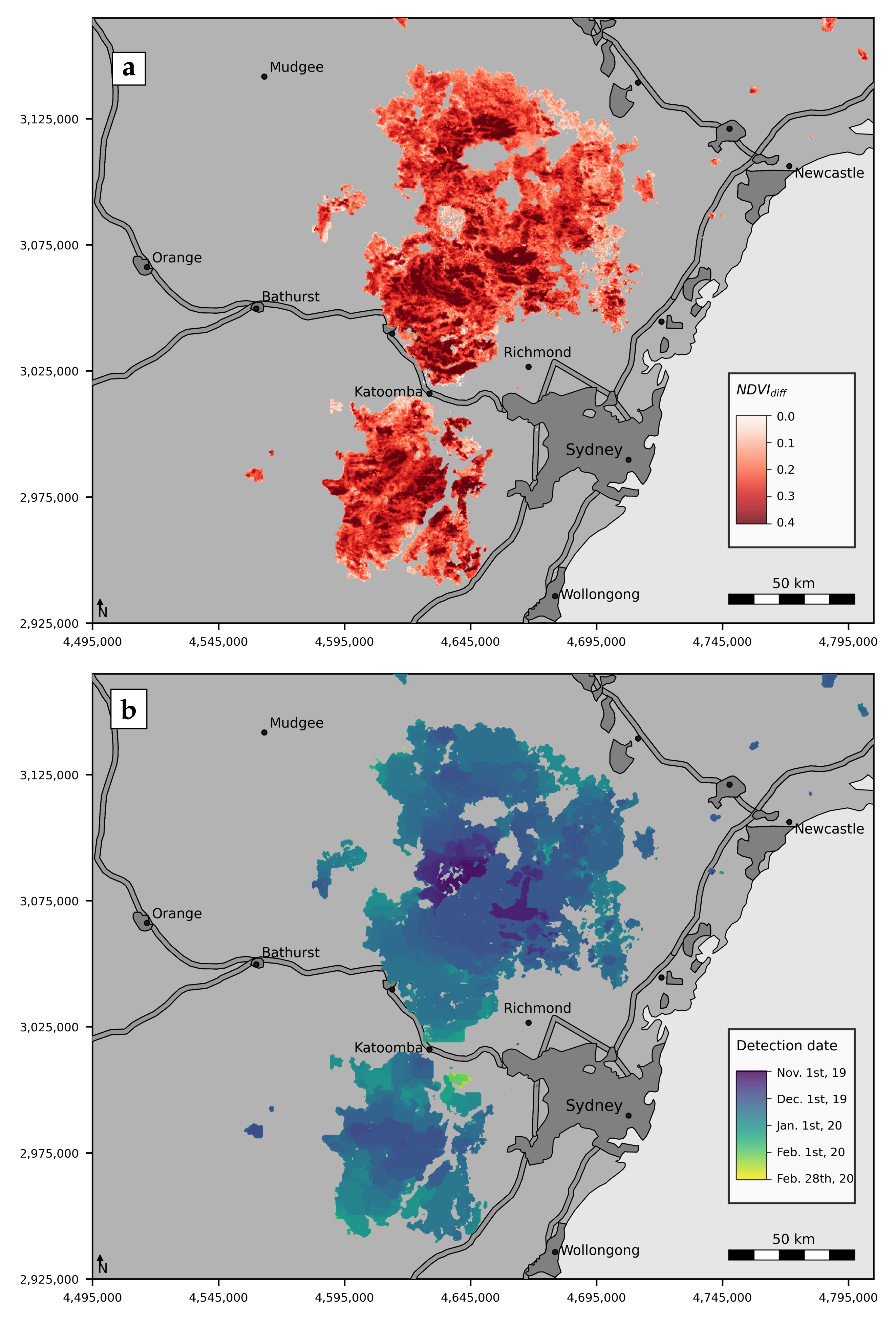
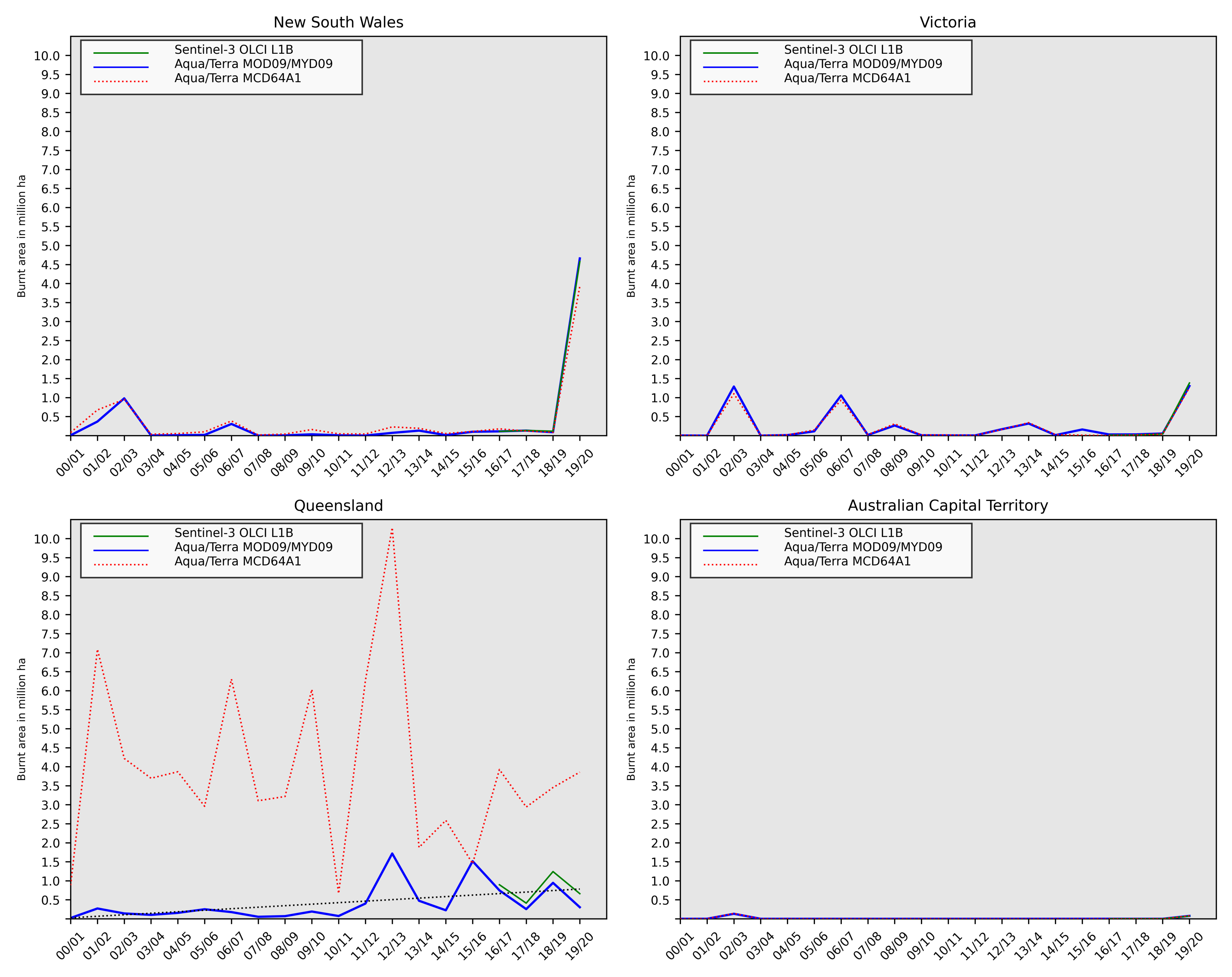
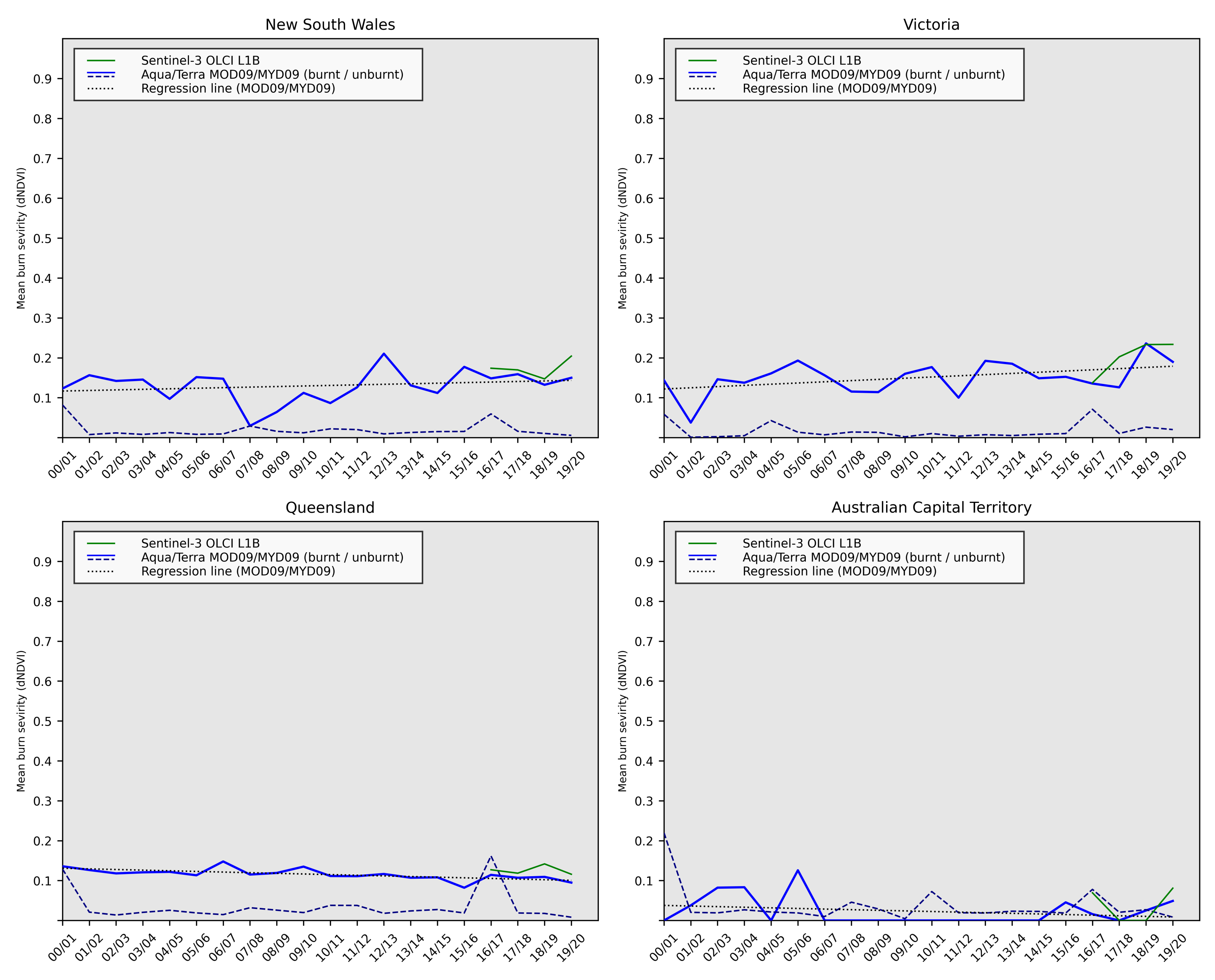
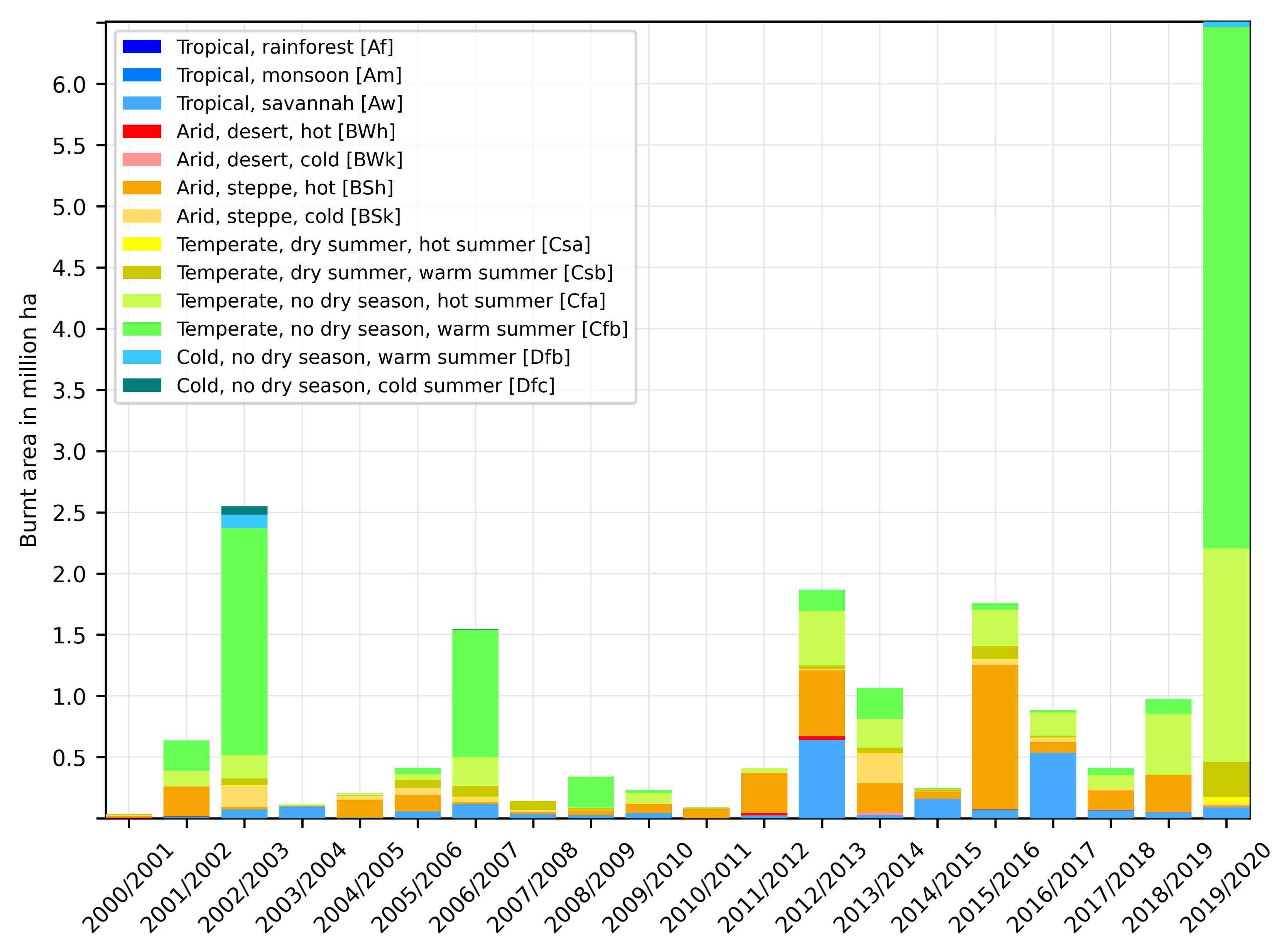
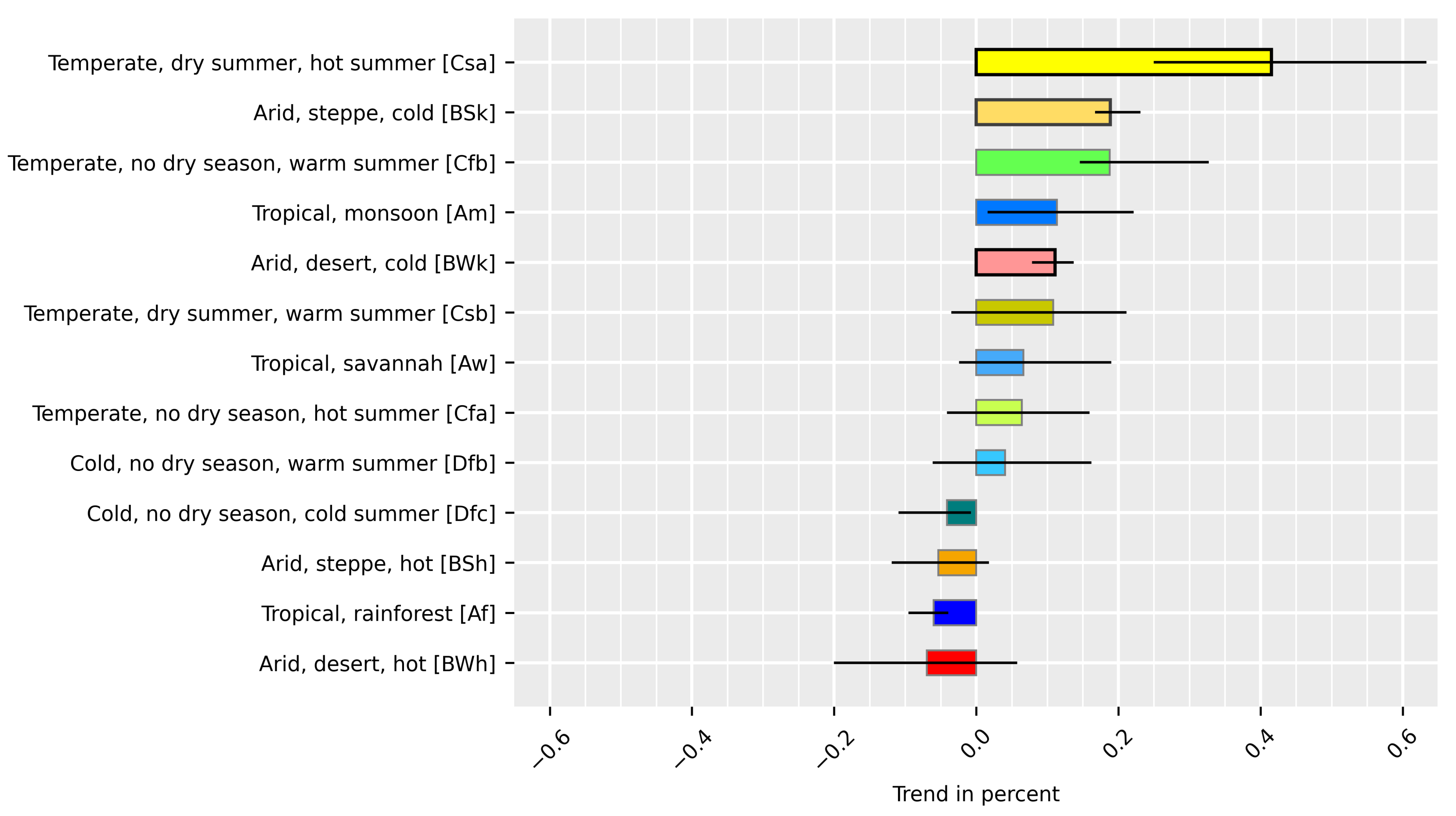
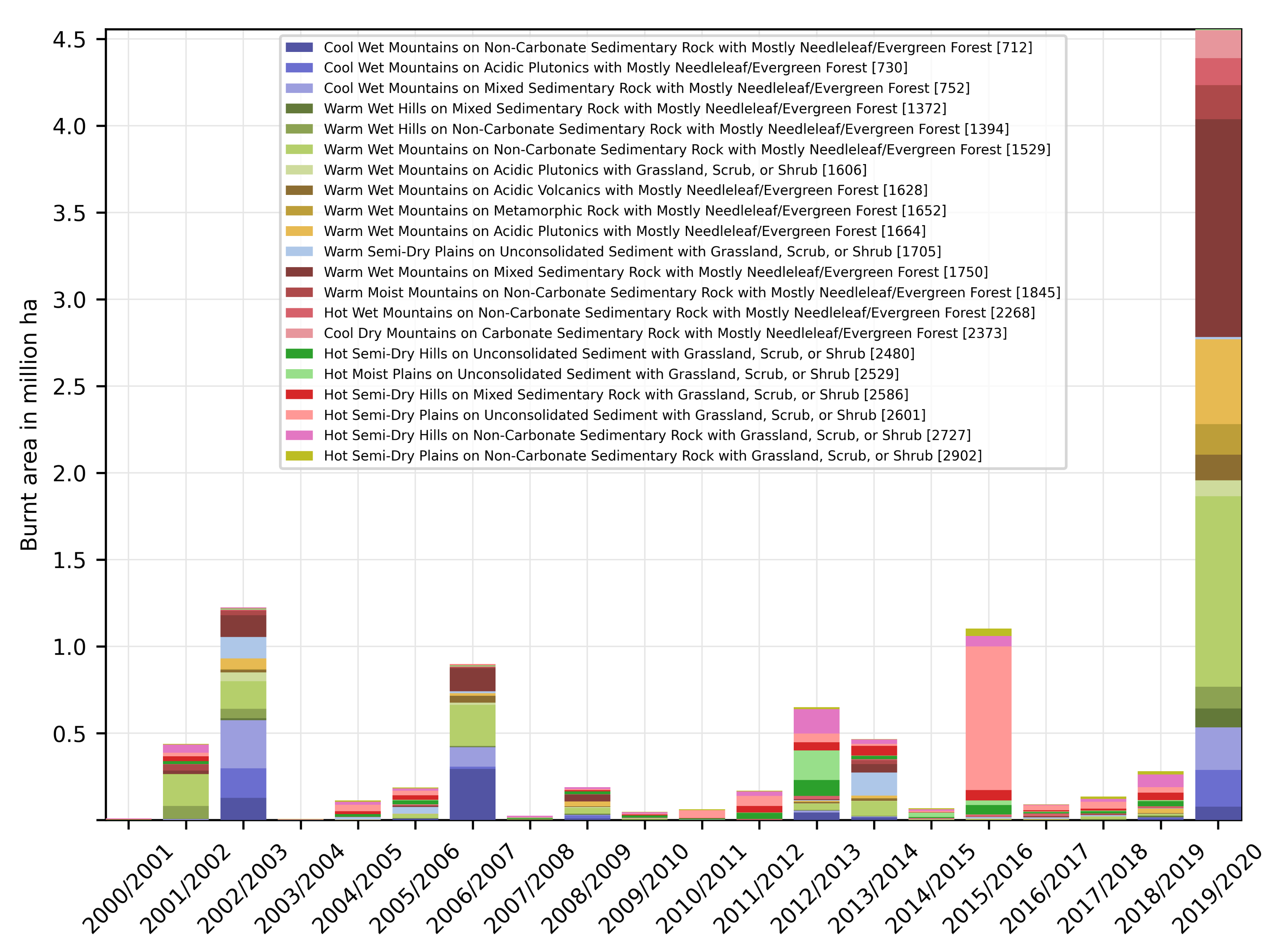
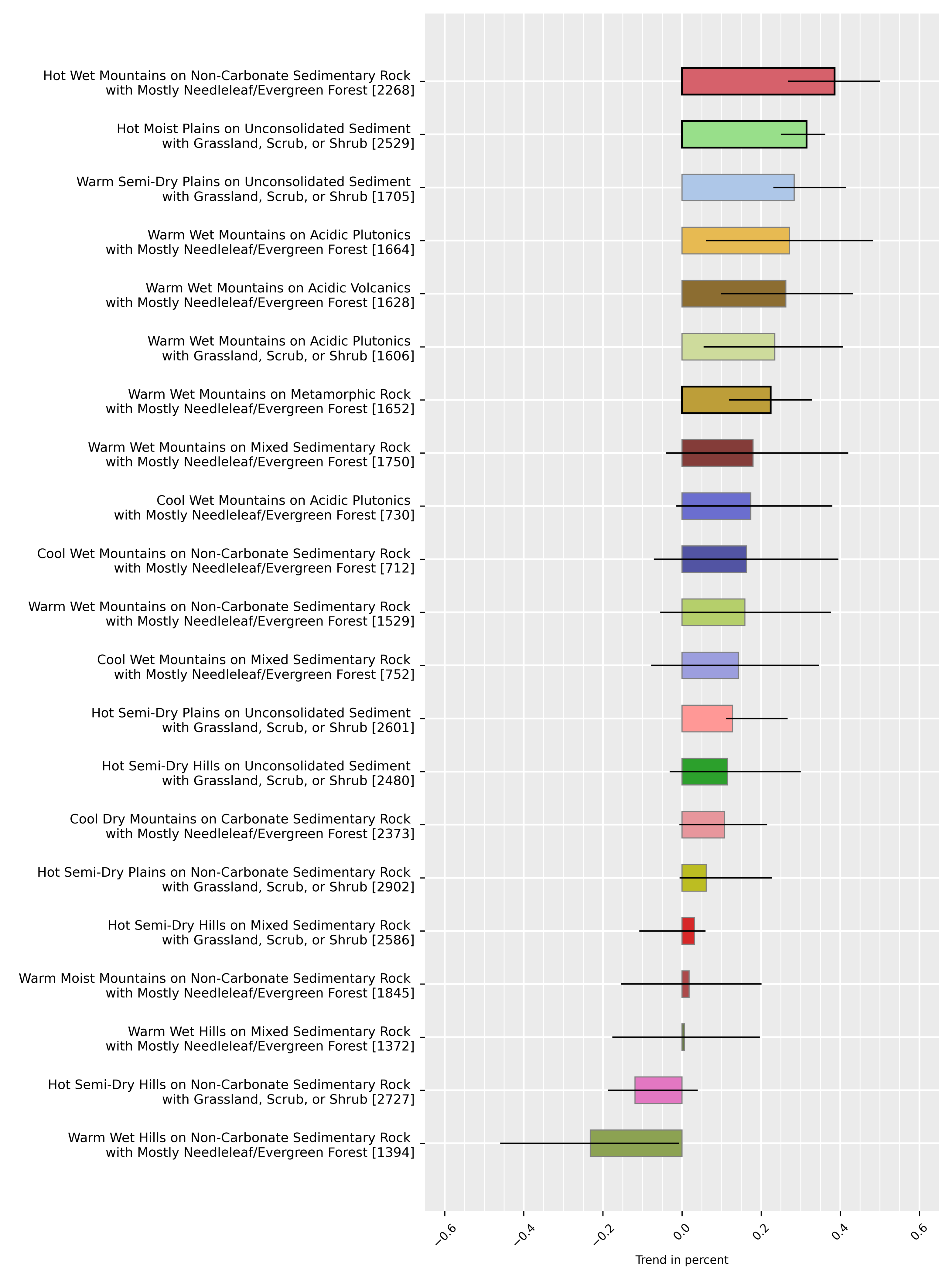
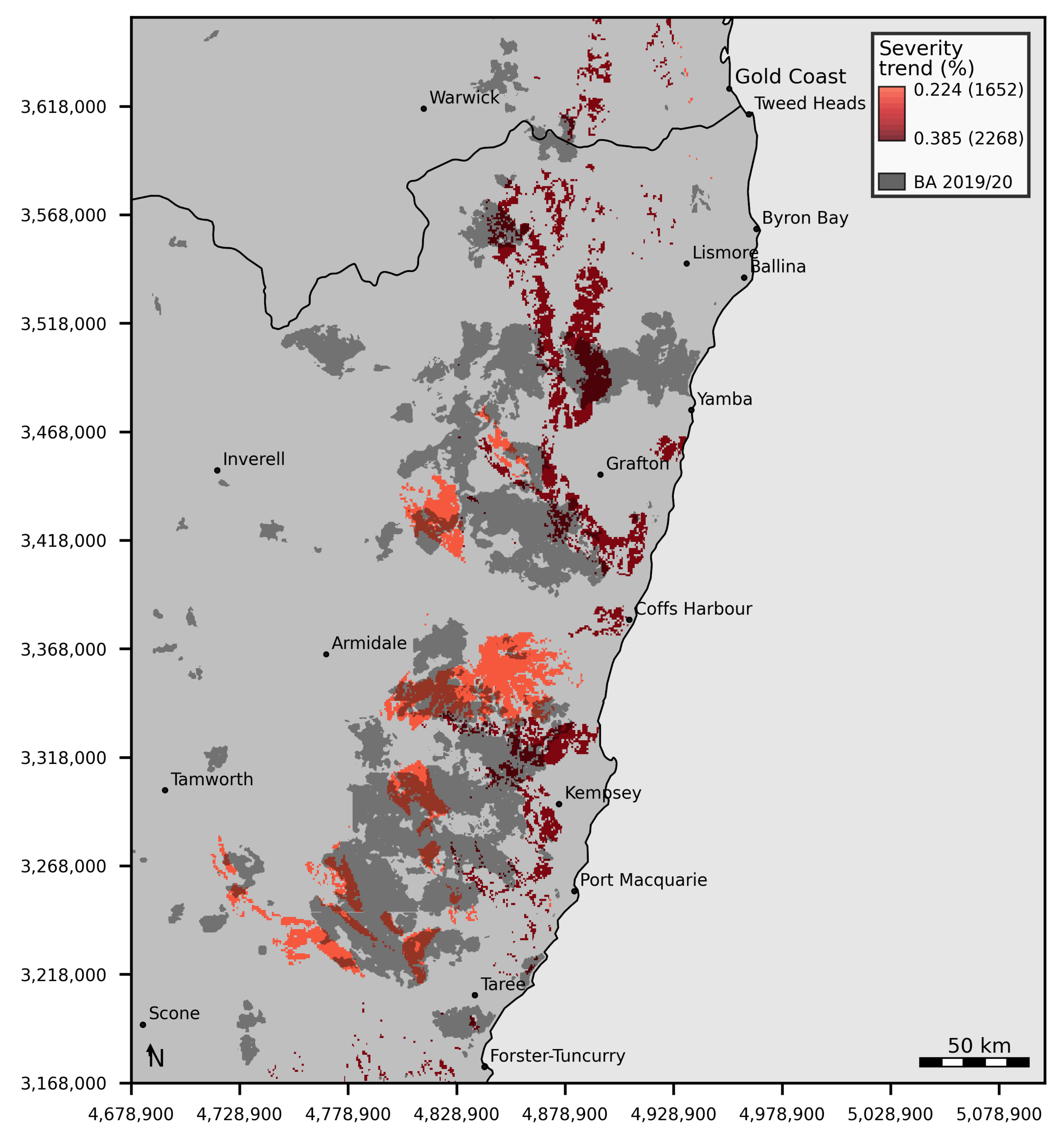
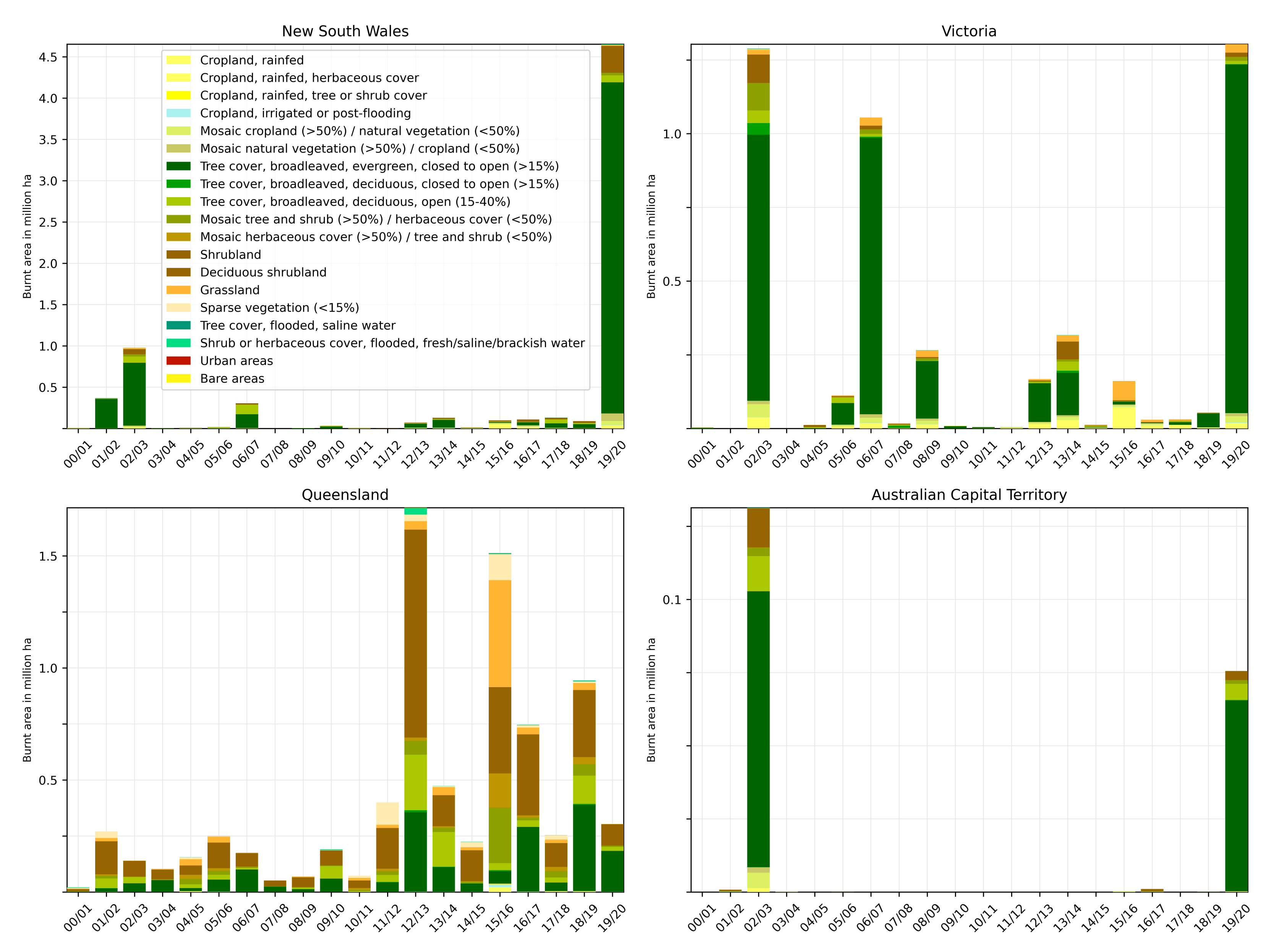
| Time Span | Sensor | Scenes | Avg. Cloud-Free Overpasses per Pixel | |||
|---|---|---|---|---|---|---|
| QLD | NSW | ACT | VIC | |||
| 2000/11–2001/02 | MODIS | 240 | 10 | 13 | 13 | 14 |
| 2001/11–2002/02 | MODIS | 240 | 15 | 15 | 14 | 15 |
| 2002/11–2003/02 | MODIS | 480 | 30 | 30 | 27 | 30 |
| 2003/11–2004/02 | MODIS | 480 | 30 | 30 | 27 | 30 |
| 2004/11–2005/02 | MODIS | 480 | 28 | 29 | 26 | 28 |
| 2005/11–2006/02 | MODIS | 484 | 30 | 30 | 27 | 30 |
| 2006/11–2007/02 | MODIS | 480 | 30 | 30 | 27 | 30 |
| 2007/11–2008/02 | MODIS | 480 | 30 | 30 | 27 | 30 |
| 2008/11–2009/02 | MODIS | 480 | 28 | 29 | 26 | 28 |
| 2009/11–2010/02 | MODIS | 480 | 30 | 30 | 27 | 30 |
| 2010/11–2011/02 | MODIS | 480 | 30 | 30 | 27 | 30 |
| 2011/11–2012/02 | MODIS | 480 | 30 | 30 | 27 | 30 |
| 2012/11–2013/02 | MODIS | 480 | 28 | 29 | 26 | 28 |
| 2013/11–2014/02 | MODIS | 480 | 30 | 30 | 27 | 30 |
| 2014/11–2015/02 | MODIS | 488 | 30 | 30 | 27 | 30 |
| 2015/11–2016/02 | MODIS | 480 | 30 | 30 | 27 | 30 |
| 2016/11–2017/02 | MODIS | 480 | 28 | 29 | 26 | 28 |
| OLCI | 620 | 33 | 45 | 36 | 34 | |
| 2017/11–2018/02 | MODIS | 480 | 30 | 30 | 27 | 30 |
| OLCI | 616 | 35 | 41 | 30 | 35 | |
| 2018/11–2019/02 | MODIS | 480 | 30 | 30 | 27 | 30 |
| OLCI | 1019 | 58 | 75 | 61 | 61 | |
| 2019/11–2020/02 | MODIS | 480 | 28 | 29 | 26 | 28 |
| OLCI | 1248 | 76 | 91 | 68 | 71 | |
| Presented Results 4,577,850 ha | MCD64A1 4,176,018 ha | GEEBAM 5,306,688 ha | ||
|---|---|---|---|---|
| presented results | TP | x | 83.8% | 77.1% |
| FN | x | 16.2% | 22.9% | |
| FP | x | 25.8% | 9.2% | |
| TP/FPinv | x | 79.0% | 84.0% | |
| MCD64A1 | TP | 76.4% | x | 71.1% |
| FN | 23.6% | x | 28.9% | |
| FP | 14.8% | x | 7.6% | |
| TP/FPinv | 80.8% | x | 81.7% | |
| GEEBAM | TP | 89.4% | 90.3% | x |
| FN | 10.6% | 9.7% | x | |
| FP | 26.5% | 36.8% | x | |
| TP/FPinv | 81.4% | 81.4% | x |
| State | Slope | Corr. Coef. | p-Value | RMSE |
|---|---|---|---|---|
| New South Wales | 0.054 | 0.31 | 0.18 | 0.962 |
| Queensland | 0.04 | 0.495 | 0.026 | 0.402 |
| Victoria | 0.002 | 0.028 | 0.91 | 0.421 |
| ACT | 0.0 | −0.072 | 0.764 | 0.032 |
| State | Slope | Corr. Coef. | p-Value | RMSE |
|---|---|---|---|---|
| New South Wales | 0.001 | 0.208 | 0.378 | 0.038 |
| Queensland | −0.002 | −0.664 | 0.001 | 0.010 |
| Victoria | 0.003 | 0.423 | 0.06 | 0.037 |
| ACT | −0.002 | −0.247 | 0.29 | 0.035 |
| State | Slope | Corr. Coef. | p-Value | RMSE |
|---|---|---|---|---|
| New South Wales | 0.0 | −0.148 | 0.53 | 0.018 |
| Queensland | 0.0 | −0.044 | 0.85 | 0.038 |
| Victoria | 0.0 | 0.05 | 0.84 | 0.019 |
| ACT | −0.002 | −0.304 | 0.19 | 0.044 |
| Class | Slope (%) | Perc 5 | Perc 95 | Corr. Coef. | p-Value | RMSE | Label |
|---|---|---|---|---|---|---|---|
| Csa | 0.070 | 0.057 | 0.080 | 0.385 | 0.09 | 0.009 | Temperate, dry summer, hot summer |
| BSk | −0.053 | −0.358 | 0.175 | −0.051 | 0.83 | 0.060 | Arid, steppe, cold |
| Cfb | 3.519 | 0.443 | 7.165 | 0.206 | 0.38 | 0.962 | Temperate, no dry season, warm summer |
| Am | 0.004 | −0.000 | 0.011 | 0.234 | 0.32 | 0.001 | Tropical, monsoon |
| BWk | 0.020 | 0.000 | 0.045 | 0.223 | 0.34 | 0.005 | Arid, desert, cold |
| Csb | 0.360 | 0.064 | 0.499 | 0.322 | 0.17 | 0.061 | Temperate, dry summer, warm summer |
| Aw | 0.883 | 0.675 | 1.449 | 0.307 | 0.19 | 0.158 | Tropical, savannah |
| Cfa | 3.422 | 3.006 | 4.467 | 0.519 | 0.019 | 0.325 | Temperate, no dry season, hot summer |
| Dfb | −0.061 | −0.117 | 0.066 | −0.142 | 0.55 | 0.024 | Cold, no dry season, warm summer |
| Dfc | −0.078 | −0.123 | −0.047 | −0.295 | 0.21 | 0.014 | Cold, no dry season, cold summer |
| BSh | 1.494 | 0.741 | 2.058 | 0.325 | 0.16 | 0.250 | Arid, steppe, hot |
| Af | −0.000 | −0.001 | 0.001 | −0.022 | 0.93 | 0.000 | Tropical, rainforest |
| BWh | 0.014 | −0.024 | 0.038 | 0.108 | 0.65 | 0.007 | Arid, desert, hot |
| Class | Slope (%) | Perc 5 | Perc 95 | Corr. Coef. | p-Value | RMSE | Label |
|---|---|---|---|---|---|---|---|
| Csa | 0.415 | 0.251 | 0.631 | 0.457 | 0.043 | 0.046 | Temperate, dry summer, hot summer |
| BSk | 0.188 | 0.169 | 0.229 | 0.418 | 0.07 | 0.023 | Arid, steppe, cold |
| Cfb | 0.187 | 0.147 | 0.325 | 0.317 | 0.17 | 0.032 | Temperate, no dry season, warm summer |
| Am | 0.113 | 0.018 | 0.219 | 0.209 | 0.38 | 0.030 | Tropical, monsoon |
| BWk | 0.111 | 0.080 | 0.135 | 0.566 | 0.009 | 0.009 | Arid, desert, cold |
| Csb | 0.108 | −0.033 | 0.209 | 0.123 | 0.61 | 0.050 | Temperate, dry summer, warm summer |
| Aw | 0.066 | −0.022 | 0.188 | 0.126 | 0.6 | 0.030 | Tropical, savannah |
| Cfa | 0.064 | −0.039 | 0.157 | 0.108 | 0.65 | 0.034 | Temperate, no dry season, hot summer |
| Dfb | 0.040 | −0.059 | 0.160 | 0.07 | 0.77 | 0.033 | Cold, no dry season, warm summer |
| Dfc | −0.040 | −0.107 | −0.009 | −0.117 | 0.62 | 0.020 | Cold, no dry season, cold summer |
| BSh | −0.053 | −0.116 | 0.016 | −0.17 | 0.47 | 0.017 | Arid, steppe, hot |
| Af | −0.059 | −0.093 | −0.041 | −0.285 | 0.22 | 0.011 | Tropical, rainforest |
| BWh | −0.069 | −0.198 | 0.055 | −0.109 | 0.65 | 0.036 | Arid, desert, hot |
| Climate Zone | Area Portion (%) | Label | |
|---|---|---|---|
| NSW | VIC | ||
| BWk | 3.8 | 3.3 | Arid, desert, cold |
| BSk | 17.9 | 36.7 | Arid, steppe, cold |
| Csa | 0.16 | 1.6 | Temperate, dry summer, hot summer |
| Cfa | 19.1 | 1.9 | Temperate, no dry season, hot summer |
| Ecological Zone | Area Portion (%) | Label | |||
|---|---|---|---|---|---|
| NSW | VIC | ||||
| BSk | Cfa | BSk | Cfa | ||
| 1372 | - | 0.1 | - | - | Warm Wet Hills on Mixed Sedimentary Rock with Mostly Needleleaf/Evergreen Forest |
| 1652 | - | 0.9 | - | - | Warm Wet Mountains on Metamorphic Rock with Mostly Needleleaf/Evergreen Forest |
| 1712 | 36.3 | 1.4 | 52.3 | 3.7 | Warm Semi-Dry Plains on Unconsolidated Sediment with Mostly Cropland |
| 2268 | - | 2.9 | - | - | Hot Wet Mountains on Non-Carbonate Sedimentary Rock with Mostly Needleleaf/Evergreen Forest |
| 2373 | - | 2.4 | - | - | Cool Dry Mountains on Carbonate Sedimentary Rock with Mostly Needleleaf/Evergreen Forest |
| 2529 | - | - | - | - | Hot Moist Plains on Unconsolidated Sediment with Grassland, Scrub, or Shrub |
| 2902 | - | - | - | - | Hot Semi-Dry Plains on Non-Carbonate Sedimentary Rock with Grassland, Scrub, or Shrub |
Publisher’s Note: MDPI stays neutral with regard to jurisdictional claims in published maps and institutional affiliations. |
© 2021 by the authors. Licensee MDPI, Basel, Switzerland. This article is an open access article distributed under the terms and conditions of the Creative Commons Attribution (CC BY) license (https://creativecommons.org/licenses/by/4.0/).
Share and Cite
Nolde, M.; Mueller, N.; Strunz, G.; Riedlinger, T. Assessment of Wildfire Activity Development Trends for Eastern Australia Using Multi-Sensor Earth Observation Data. Remote Sens. 2021, 13, 4975. https://doi.org/10.3390/rs13244975
Nolde M, Mueller N, Strunz G, Riedlinger T. Assessment of Wildfire Activity Development Trends for Eastern Australia Using Multi-Sensor Earth Observation Data. Remote Sensing. 2021; 13(24):4975. https://doi.org/10.3390/rs13244975
Chicago/Turabian StyleNolde, Michael, Norman Mueller, Günter Strunz, and Torsten Riedlinger. 2021. "Assessment of Wildfire Activity Development Trends for Eastern Australia Using Multi-Sensor Earth Observation Data" Remote Sensing 13, no. 24: 4975. https://doi.org/10.3390/rs13244975
APA StyleNolde, M., Mueller, N., Strunz, G., & Riedlinger, T. (2021). Assessment of Wildfire Activity Development Trends for Eastern Australia Using Multi-Sensor Earth Observation Data. Remote Sensing, 13(24), 4975. https://doi.org/10.3390/rs13244975






